Pantech PX-600 Dual-Band CDMA/ EVDO USB Modem User Manual UM150AL PX 600 1015 indd
Pantech Co., Ltd. Dual-Band CDMA/ EVDO USB Modem UM150AL PX 600 1015 indd
Pantech >
Contents
- 1. Users Manual
- 2. Manual
- 3. User Manual
Manual
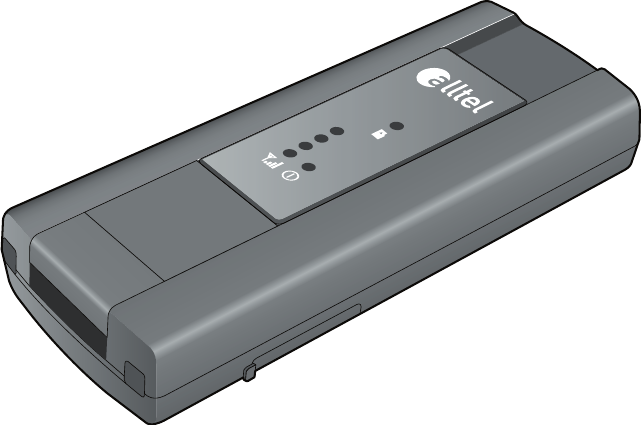
UM
150
Wireless Internet Card
User Manual
Alltel QuickLink Mobile

CONTENTS
CONTENTS
1. BEFORE USING YOUR UM
150
.........................................................1
1.1 About this User’s Manual ...................................................................... 1
1.2 Product Overview ................................................................................. 1
1.3 Product Package Contents ................................................................... 1
1.4 Introduction to Your UM
150
Wireless Internet Card ............................. 1
1.5 Product Features .................................................................................. 2
1.6 Product Handling .................................................................................. 3
1.7 Configuration ........................................................................................ 3
2. INSTALLATION AND SETUP FOR THE QUICKLINK MOBILE ....... 4
2.1 The QuickLink Mobile Setup Program .................................................. 4
2.2 The QuickLink Mobile Setup Wizard .................................................... 7
3. USING QUICKLINK MOBILE ............................................................ 9
3.1 Features ................................................................................................ 9
3.2 Getting Started ................................................................................... 10
3.3 Connecting ......................................................................................... 11
3.4 Using Dial Up Connections ................................................................ 13
4. QUICKLINK MOBILE PREFERENCES .......................................... 14
4.1 General Preferences .......................................................................... 14
4.2 WWAN Specific Settings .................................................................... 16
4.3 Additional Features ............................................................................. 19
5. INSTALLING UM
150
........................................................................ 24
5.1 Precautions ......................................................................................... 24
5.2 Recommended System Requirements .............................................. 24
5.3 Installing Software .............................................................................. 25
5.3.1 Warnings ................................................................................................. 25
5.3.2 Notes ....................................................................................................... 25
5.3.3 Unplugging or Ejecting the Device ......................................................... 26
5.3.4 Using the Device ..................................................................................... 28
5.3.5 Using the Wireless Internet Card Extension Cable ................................ 29
6. REGULATORY AND SAFETY INFORMATION .............................. 30
6.1 Regulatory Notices ............................................................................. 30
6.2 Operating Conditions ......................................................................... 30
6.3 Warnings and Cautions ..................................................................... 30
6.4 Safety Precautions ........................................................................... 31

UM
150
User’s Manual 1
UM
150
User’s Manual 1
UM
150
User’s Manual
1. BEFORE USING UM
150
1.1 About this User’s Manual
You will find all the information you need to install and use the UM
150
in this user’s
manual. Before using the UM
150
, you must properly install the UM
150
by following
the installation instructions.
Instructions
• Before inserting the UM
150
Wireless Internet Card into your computer, install
the UM
150
software. The installation software is included in the product
package. Insert the CD into your CD-ROM drive. Installation may take a few
minutes.
• It is highly recommended that you read the safety precautions in this manual
before using the UM
150
.
1.2 Product Overview
Thank you for purchasing the Alltel UM
150
Wireless Internet Card.
The UM
150
is a 3G wireless device that enables high-speed wireless
communication from your PC. The UM
150
is simple to install and use.
1.3 Product Package Contents
Following items are included in the product package. If any of the items listed below
are missing, please contact the retail location where you purchased the product.
- UM
150
Wireless Internet Card
- Installation CD that containing software and user’s manual
- Wireless Internet Card extension cable
- Quick Start Guide
1.4 Introduction to Alltel UM
150
Wireless Internet Card
The Alltel UM
150
is designed for your PC’s USB port, which is available in most PC
models. The UM
150
can be used to access the Internet, your company’s intranet, or
you can use it to send and receive email. It is extremely useful when you are away
from the office, on the road, or where ever a wireline Internet access is not readily
available.
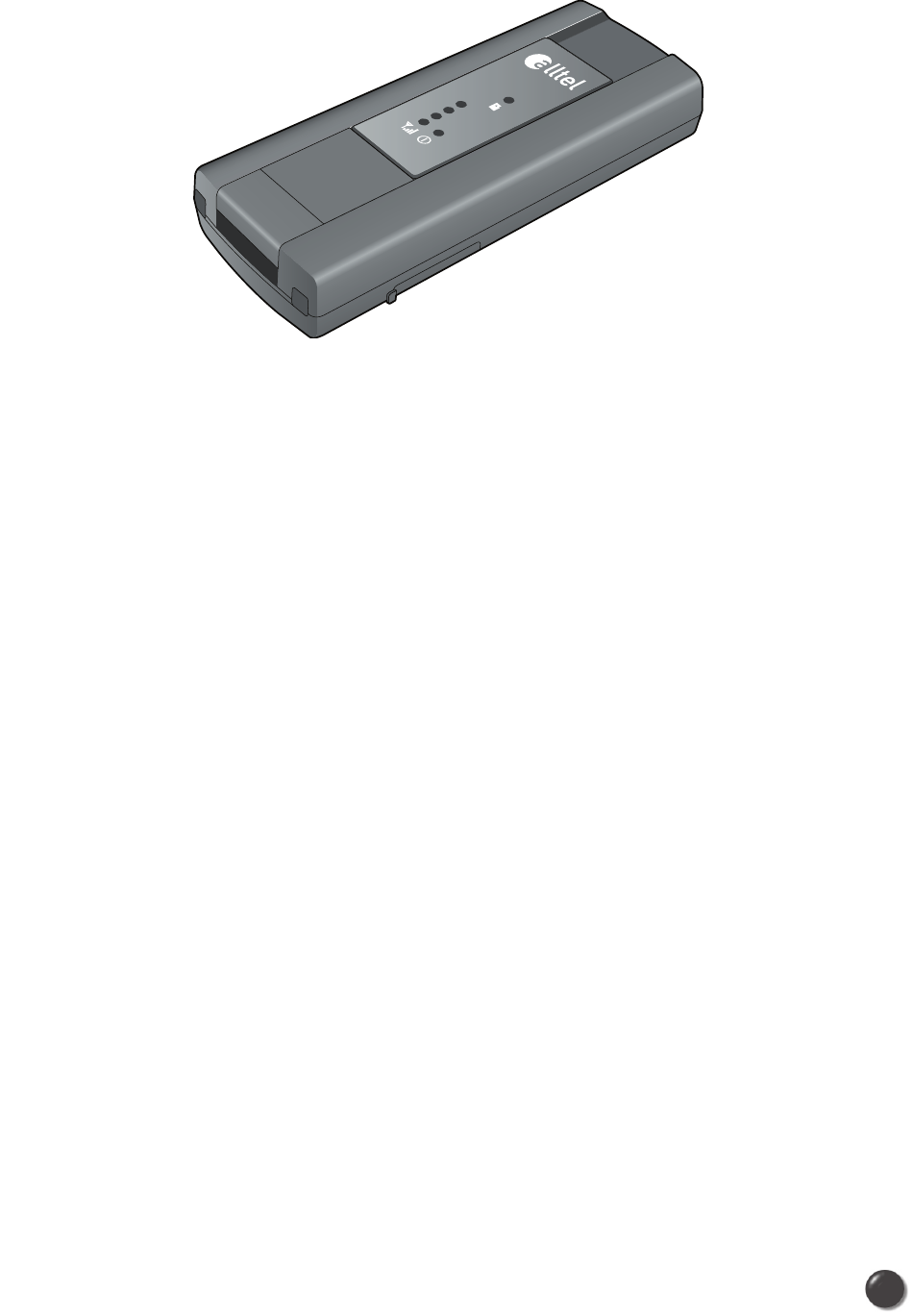
UM
150
User’s Manual 2
UM
150
User’s Manual
1.5 Product Features
- Power management: The UM
150
utilizes power management and system
overhead reduction functions provided by the USB interface for maximum power
savings.
- Antenna design: Efficient, innovative design optimizes data transfer rate and
sensitivity to network signals.
- Extension Y Cable connector: Simply insert the USB connector into the USB port
of your computer to deliver a DC power supply, increased RF performance, and to
solve clearance issues.
- External Memory: Provides MicroSD™ card slot for an External Memory Card for
storing sounds, pictures, and videos (* MicroSD card is optional)
- Wireless Internet Card that supports USB interface.
- Supports North American PCS (1900 MHz) and Cellular (800 MHz) bands.
- Utilizes QUALCOMM MSM6800 chip set.
- Supports 3G network technologies.
- Average Data Rate: 600 Kbps to 1.4 Mbps download; 500 Kbps to 800 Kbps
upload.
- Supports Windows XP and Vista systems with installed host software and driver.
- Compatible with Mac OS X 10.3.9 and higher.
- Provides Alltel Wireless Internet service.

UM
150
User’s Manual 3
UM
150
User’s Manual
1.6 Product Handling
1) Do not put any adhesive label on the USB connector. It may leave a sticky
residue that can cause problems inside the PC USB port.
2) The UM
150
USB device should easily slide into the USB port.
Do not force the UM
150
into the USB port as it may cause damage to the
modem and/or the port.
3) Keep the UM
150
in a dry and clean place.
(Storage temperature: -22°F to 149°F [- 30°C to 65°C]). Keep your device away
from liquids, dust and excessive heat.
1.7 Configuration
To use the UM
150
, you should install the software included in the installation CD
and configure the UM
150
USB device. See the next section for more infomration on
software installation and USB device configuration.
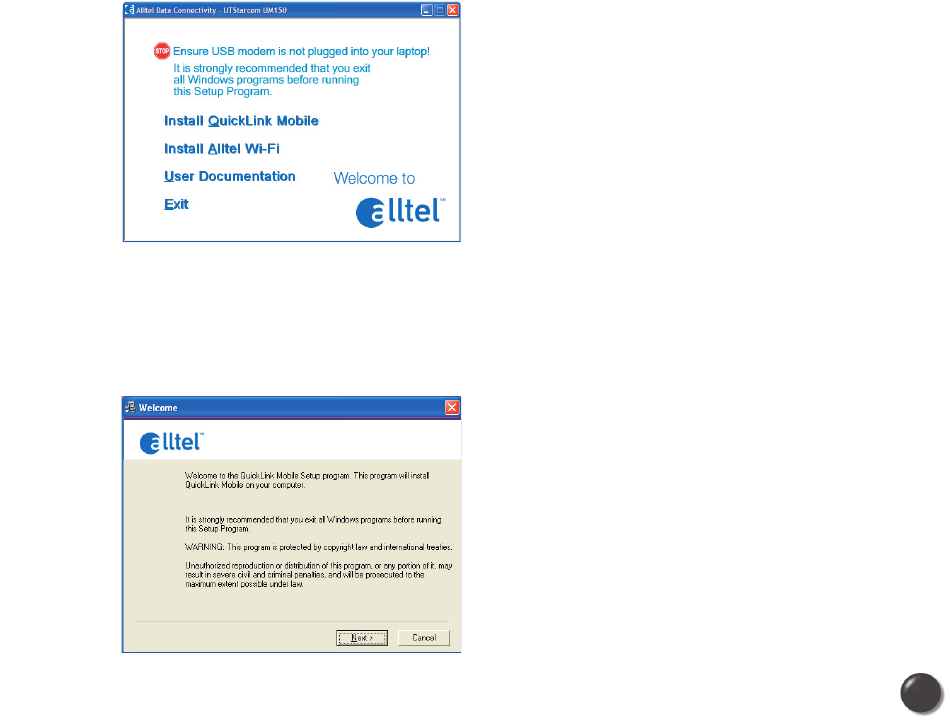
UM
150
User’s Manual 4
UM
150
User’s Manual
2. INSTALLATION AND SETUP FOR THE QUICKLINK MOBILE
This section will guide you through the installation and setup process for the
QuickLink Mobile. Before getting started, you should become familiar with the
documentation that came with your mobile phone or Wireless Internet Card.
CD’s
1. If you purchased the UM150 Wireless Internet Card, there is only one CD that
contains the QuickLink Mobile and Wireless Internet Card drivers.
Getting Started
To install the QuickLink Mobile:
1. Turn on your computer then close all applications.
2. Insert the CD-ROM into your CD drive.
3. If set up does not automatically start, click the Start button on the taskbar then
choose Run. Type D:\Start (where D is the letter of your CD-ROM drive) then click
OK.
4. Follow the steps in the next section.
* QuickLink Mobile software must be installed before you insert the Wireless Internet
Card into the computer for the first time. Only after the software has been installed
can Windows successfully install and configure the Wireless Internet Card.
2.1 The QuickLink Mobile Setup Program
STEP 1: Click the QuickLink Mobile setup program. The “Welcome” screen appears.
Click the Next button to continue with the installation process.
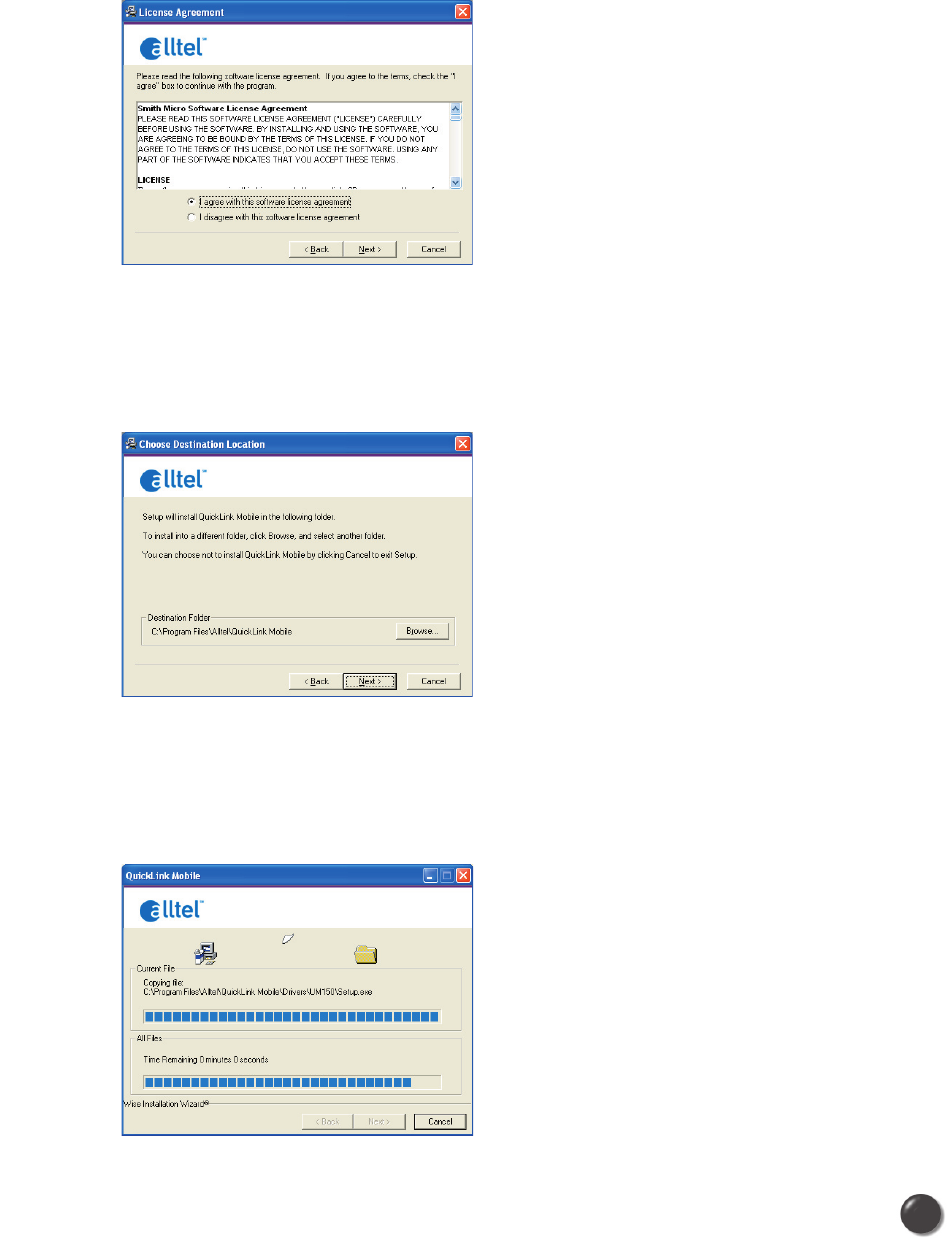
UM
150
User’s Manual 5
UM
150
User’s Manual
STEP 2: After the Welcome screen you will see the QuickLink Mobile License
Agreement. In order to install and use this product you must agree with the
terms of this agreement. Select “I agree with this software license agreement”,
then click the Next button to continue. If you do not agree with this agreement,
click the Cancel button to exit.
STEP 3: You are now ready to select the location on your computer where
the QuickLink Mobile should be installed. It is recommended that you do not
modify the default destination folder. Click the Next button to continue.
STEP 4: During this step the components of the QuickLink Mobile product are
being installed onto your computer.
Installation will occur to the destination folder specified in Step 3 above.

UM
150
User’s Manual 6
UM
150
User’s Manual
STEP 5: Installation is now complete. Click the Finish button to leave the
QuickLink Mobile setup program and begin using your new software.
* The setup program will automatically create a QuickLink Mobile shortcut on
your desktop.
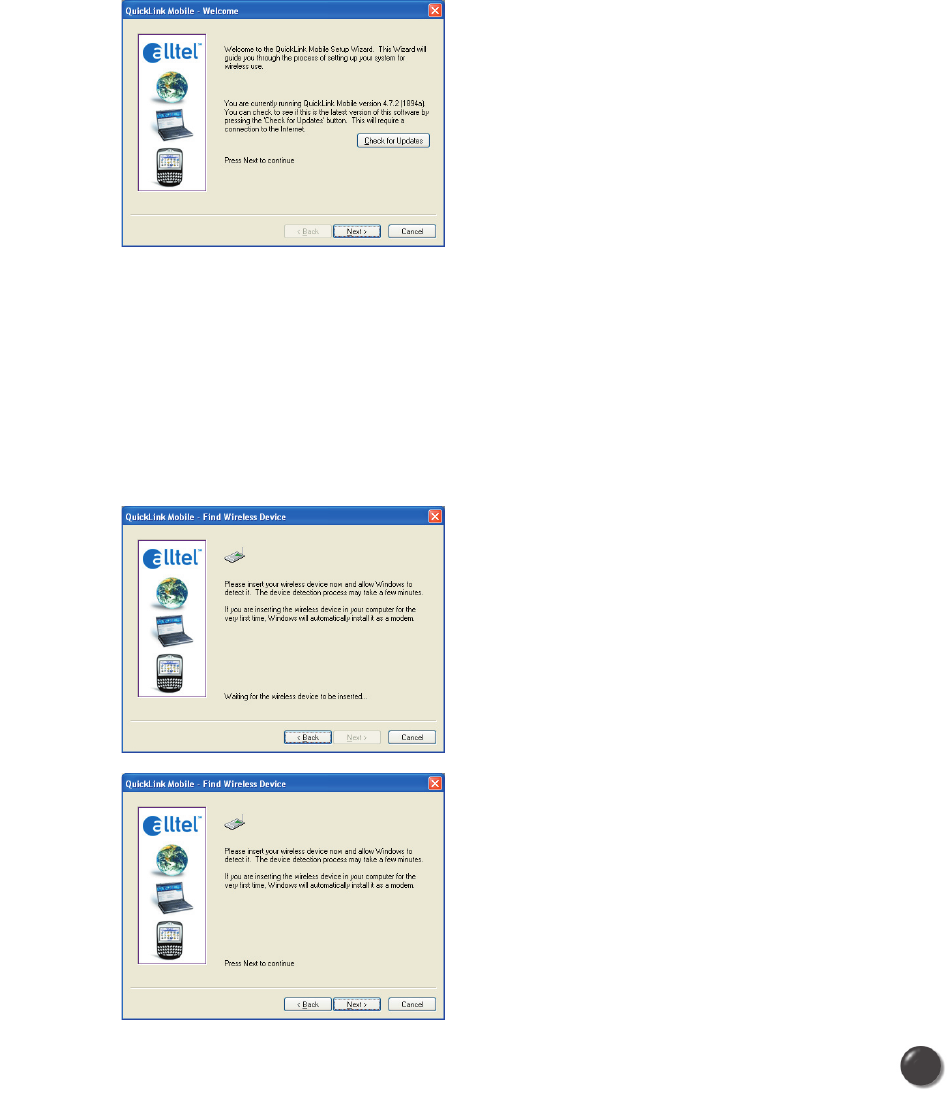
UM
150
User’s Manual 7
UM
150
User’s Manual
2.2 The QuickLink Mobile Setup Wizard
After you have successfully completed the installation process of QuickLink Mobile,
you are ready to start the QuickLink Mobile program and begin your initial setup. The
steps in the Setup Wizard are critical to the proper operation of QuickLink Mobile.
STEP 1: To start the QuickLink Mobile program click the Start button, select the
Programs menu and choose the QuickLink Mobile menu item.
STEP 2: On first-run of QuickLink Mobile the Setup Wizard will automatically
run. The “Welcome” screen appears.
If you have an Internet connection, it is recommended that you check to see
if you are running the latest version of QuickLink Mobile. Click the Check for
Updates button to perform this check.
Click Next to continue.
STEP 3: Insert your UM
150
, then wait for Windows to detect and install drivers for
the device.
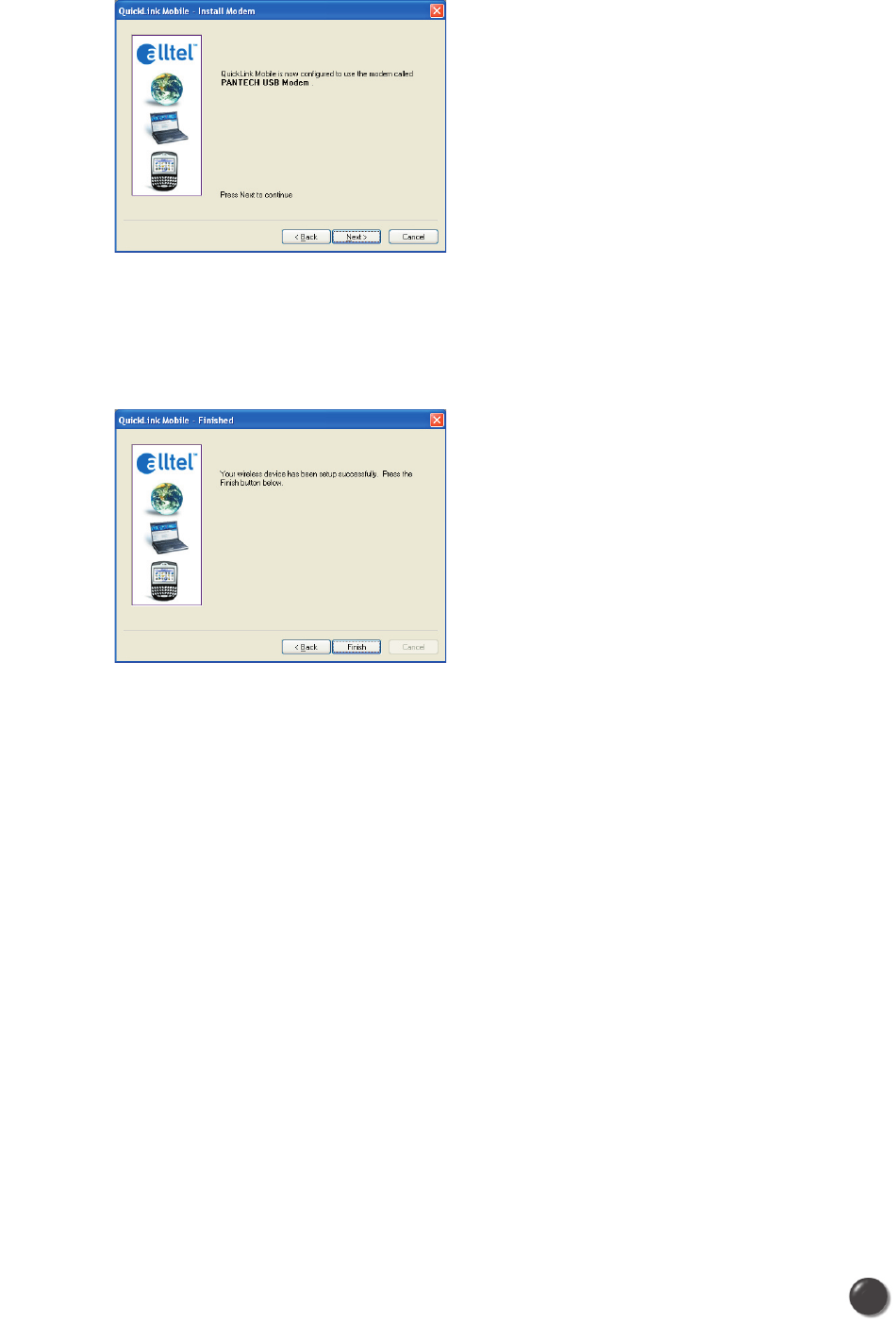
UM
150
User’s Manual 8
UM
150
User’s Manual
STEP 4: The detection and configuration process for your wireless device is now
complete. In this step you can elect to run the QuickLink Mobile automatically every
time you start your computer. To do so, check the “Run QuickLink Mobile at Startup”
checkbox. Click Finish when complete.
Please familiarize yourself with the information in the “Using QuickLink Mobile” and
“Connecting to the Internet” sections of this guide.

UM
150
User’s Manual 9
UM
150
User’s Manual
3. USING QUICKLINK MOBILE
Today’s online world offers more services everyday and Alltel Wireless gives
you the tools you need to take advantage of the best in connectivity solutions.
With QuickLink Mobile, enjoy the freedom and convenience of wireless Internet
connectivity from your computer!
3.1 Features
WWAN (Wireless Wide Area Network, 1xEV-DO/1xRTT/CDMA)
Specific Features:
• Configures your PC to use your wireless device as a modem.
• Creates an Alltel Wireless Internet connection if using an Alltel Wireless
Internet capable device.
• Copy utility to create wireless copies of your dial-up connections, if supported
by your device.
• Signal strength and battery level display for most wireless phones.
• Test function for WWAN device.
* A WWAN capable device is required to use the WWAN features. Individual WWAN
features are also device dependent as described in the WWAN section above.
Other Features:
• Can also be used to launch all of your dial-up networking connections, if
desired.
• Can launch your browser, e-mail client, VPN or a program of your choice upon
connection.
• Logs connections used, duration and bytes sent and received.
• See the section “Additional Features” for more information about the features of
QuickLink Mobile.
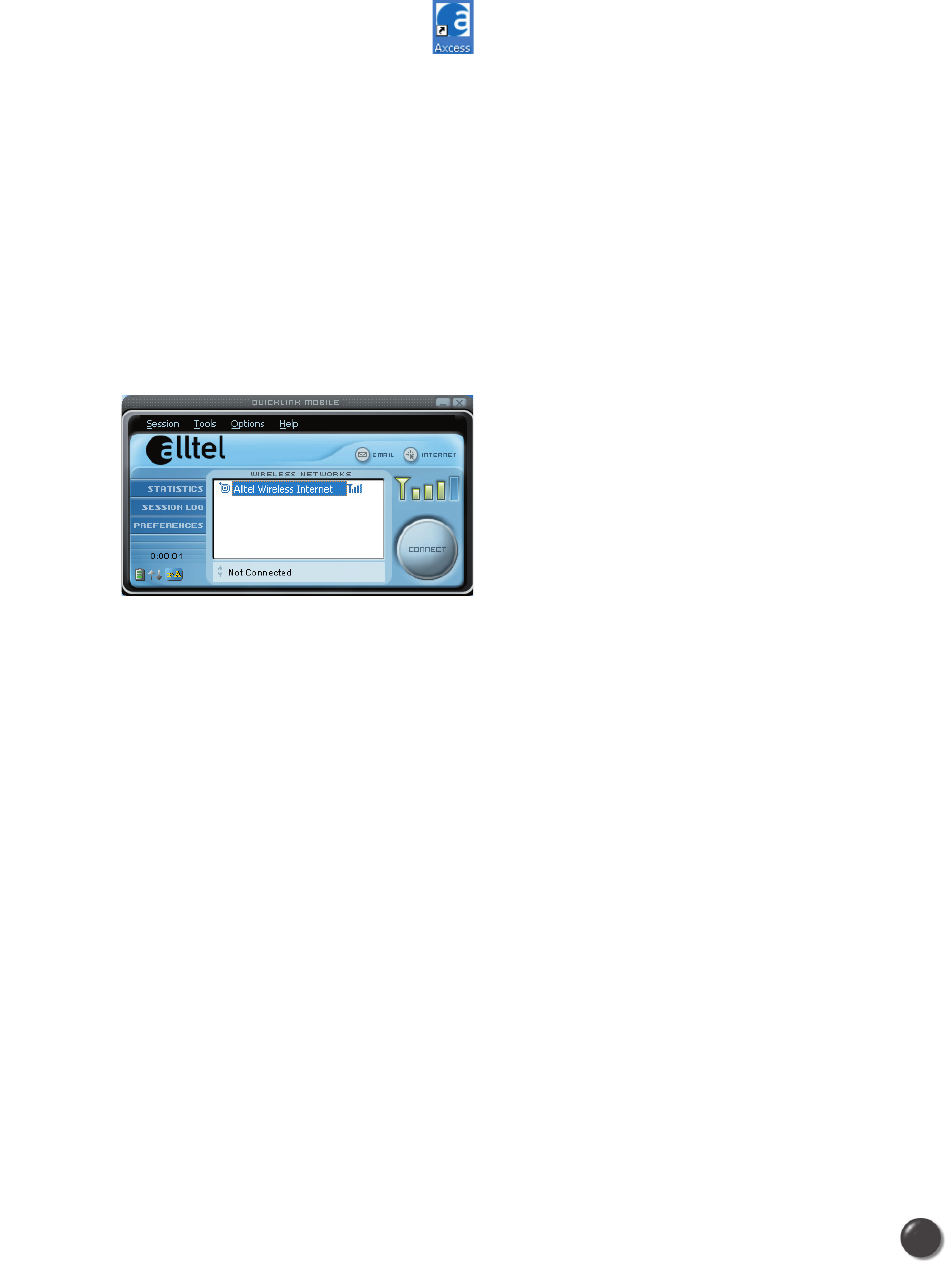
UM
150
User’s Manual 10
UM
150
User’s Manual
3.2 Getting Started
Double click on the QuickLink Mobile icon on your desktop or click on the Windows
Start menu and select QuickLink Mobile from the list of Programs.
About the Wireless Networks View
The QuickLink Mobile will open the Wireless Networks window by default.
This view is where you manage your wireless connections.
The Wireless Networks window displays all currently available network
connections.
At a glance you can see the signal strength and battery level.
Select “Refresh Networks” from the “Tools” menu to update the information
in this panel. Your current connection state and the elapsed time of the
connection are displayed along the bottom of the status bar.
If your expected connection does not appear or if you connected your wireless
phone and cable, or inserted your Wireless Internet Card after starting QuickLink
Mobile, select “Refresh Networks” from the “Tools” menu. This will cause QuickLink
Mobile to look for your wireless device(s) and verify network availability.
* If you change phones or Wireless Internet Cards, you will need to run the Setup
Wizard again. To do this make sure that your phone and cable are connected, then
select “Run Wizard” from the “Tools” menu.

UM
150
User’s Manual 11
UM
150
User’s Manual
3.3 Connecting
Once your device is properly configured, connecting to the Internet is as simple as
selecting the network connection type shown in the list and clicking the connect
button.
1. Select Alltel Wireless Internet.
2. Click the “Connect” button when it becomes enabled.
Once connected, the “Connect” button will change to “Disconnect”. Simply
click this to end your current connection. To connect to any other network
shown, select it, and then select “Connect”.
The Status Bar
Information regarding your current network connection can be seen in the
status bar along the bottom of the QuickLink Mobile interface. For more
information on this status bar, see the section “The Status Bar” in the
“Additional Features” section.
* If you are using a WWAN (1xEV-DO/1xRTT/CDMA) device that supports the
Alltel Wireless Dial-Up-Data service and you made wireless copies of your
dial-up accounts, they will also appear. See the section “Creating Wireless
Copies of your Dial-Up Connections”. Optionally you can have all dial-up
connections appear in QuickLink Mobile and use it to launch any dial-up
networking connection.
* The first time you connect with the Alltel Wireless Internet connection, a
connectivity warning message will appear. You have the option to suppress these
warning messages when they are displayed.
QuickLink Mobile will display status information at the bottom during the
connection process as well as while connected. When not connected, the status
text will display “Not connected” for the currently selected network. The timer will
display “00:00:00”. Once connected, the status text will display “Connected” and
the elapsed timer will begin to run.
The pop up status can be turned off, if desired, by selecting “Options”,
“Preferences”, “Options” tab, un-checking “Show popup status windows
by tray”. Right clicking on the tray icon provides various options and double
clicking on it will always show the application. Placing your cursor on it will
display the current connection status.
Based on your preferences, your browser or e-mail or VPN program can be
launched automatically, or you can launch whatever software you want to
use. To determine if all connections appear in the drop down list or only your
wireless ones.
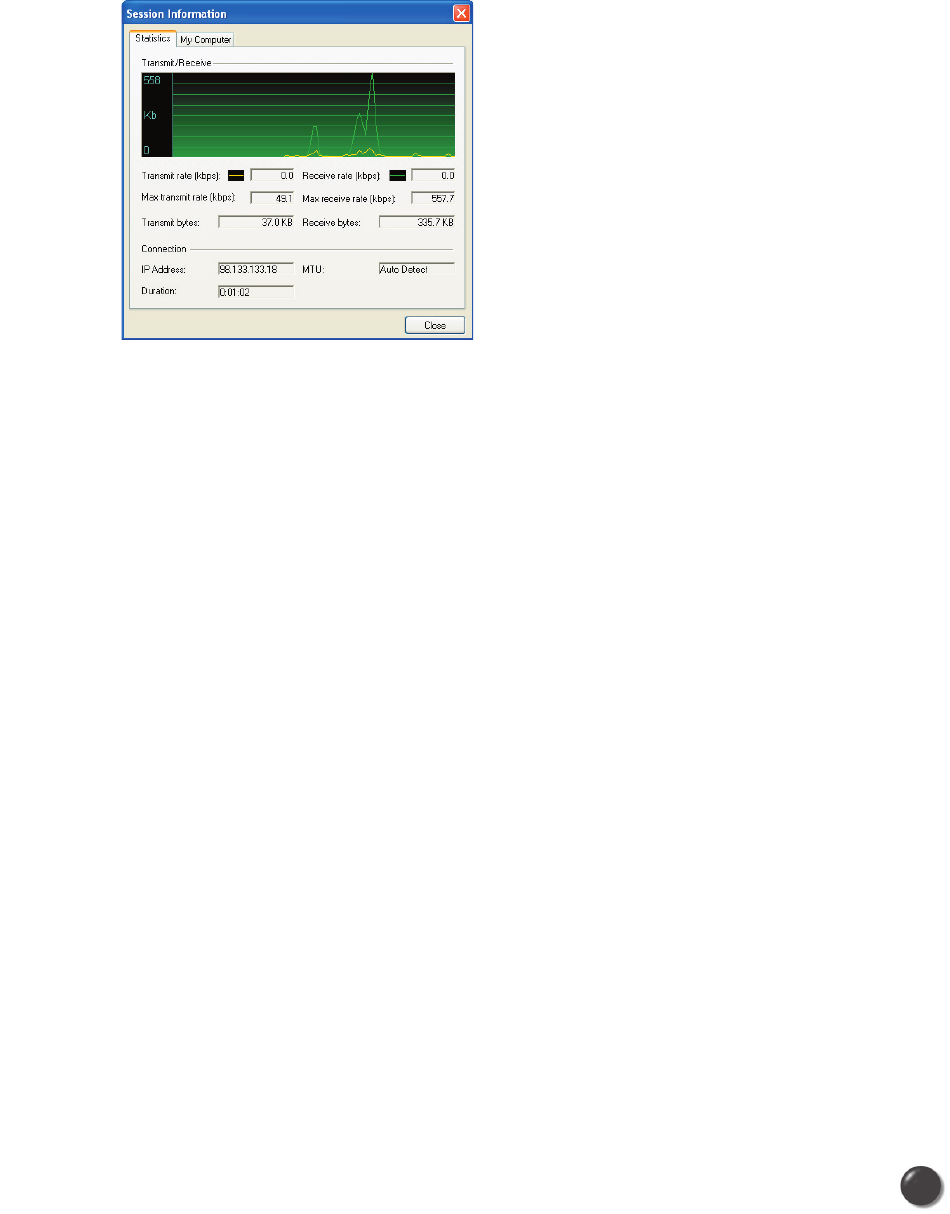
UM
150
User’s Manual 12
UM
150
User’s Manual
* Always use QuickLink Mobile when connecting via the Alltel Wireless Internet
connection.
At any time during your connection you can check your current connection speed
and throughput stats in the Statistics tab of the Session Information window. To see
this window, select “Statistics” from the “Session” menu.
The Session Information window will also contain a My Computer tab if applicable.
The My Computer tab contains detailed information about your computer. This
information is helpful when troubleshooting a problem.
Additional information when using the “Alltel Wireless Internet” connection:
By default QuickLink Mobile enables the internet accelerator software for the Alltel
Wireless Internet connections.
If you are using the Alltel Wireless Internet connection and the call fails when you
try to connect, with QuickLink Mobile returning to its idle state, you should try to
connect again. If you feel you may have incorrectly entered your wireless device
number during initial setup, select “Tools”, “Run Wizard”.
Dormancy:
Alltel Wireless Internet data sessions become dormant if you are not sending or
receiving any data. As soon as you resume sending or receiving data, the data
session will return to an active state.
Depending on your device and your Alltel Wireless Internet plan, your data session
may disconnect during a dormant state.
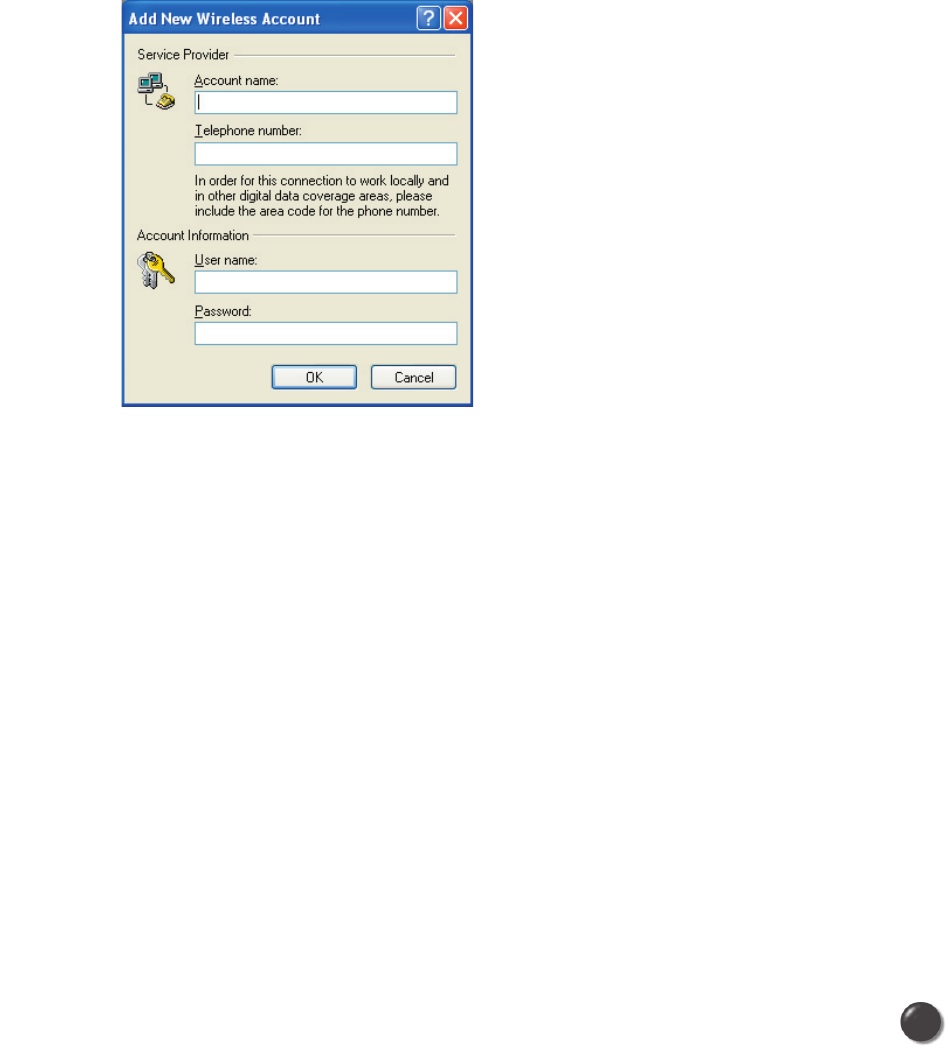
UM
150
User’s Manual 13
UM
150
User’s Manual
3.4 Using Dial Up Connections
This section is only applicable if you are using a WWAN Device that supports
Dial-Up connections (a wireless phone and cable or a Wireless Internet Card).
You can make wireless copies of existing dial up accounts on your system.
This will wirelessly enable them and allow you to connect to them wirelessly.
To launch the copy utility, select “Options”, “Dial-up Accounts” then “Copy”.
Click on the connection or connections you want to copy and click on the
“OK” button.
The new connection will have a suffix of “(Wireless)” and will be set to use
your wireless phone as the modem. If the utility is unable to automatically
recognize your existing area code and number, the existing number will be
displayed, and you will be prompted to enter the area code and number. The
utility configures the new wireless connections to always dial 11 digits, so that
they will work locally and also in other digital data coverage areas.
If it is determined that the connection might benefit by further optimization, an
additional connection with a “(Wireless Optimized)” suffix, will also be created.
This connection may connect faster. If you have trouble with the “(Wireless
Optimized)” connection, you can delete it from your dial-up networking folder
and use the “(Wireless)” connection.
To delete connections:
Windows XP users can access Dial-Up Networking from QuickLink Mobile by
selecting “Options”, “Control Panels”, “Network and Dial-up Connections”, right click
on the desired connection and select “Delete”.
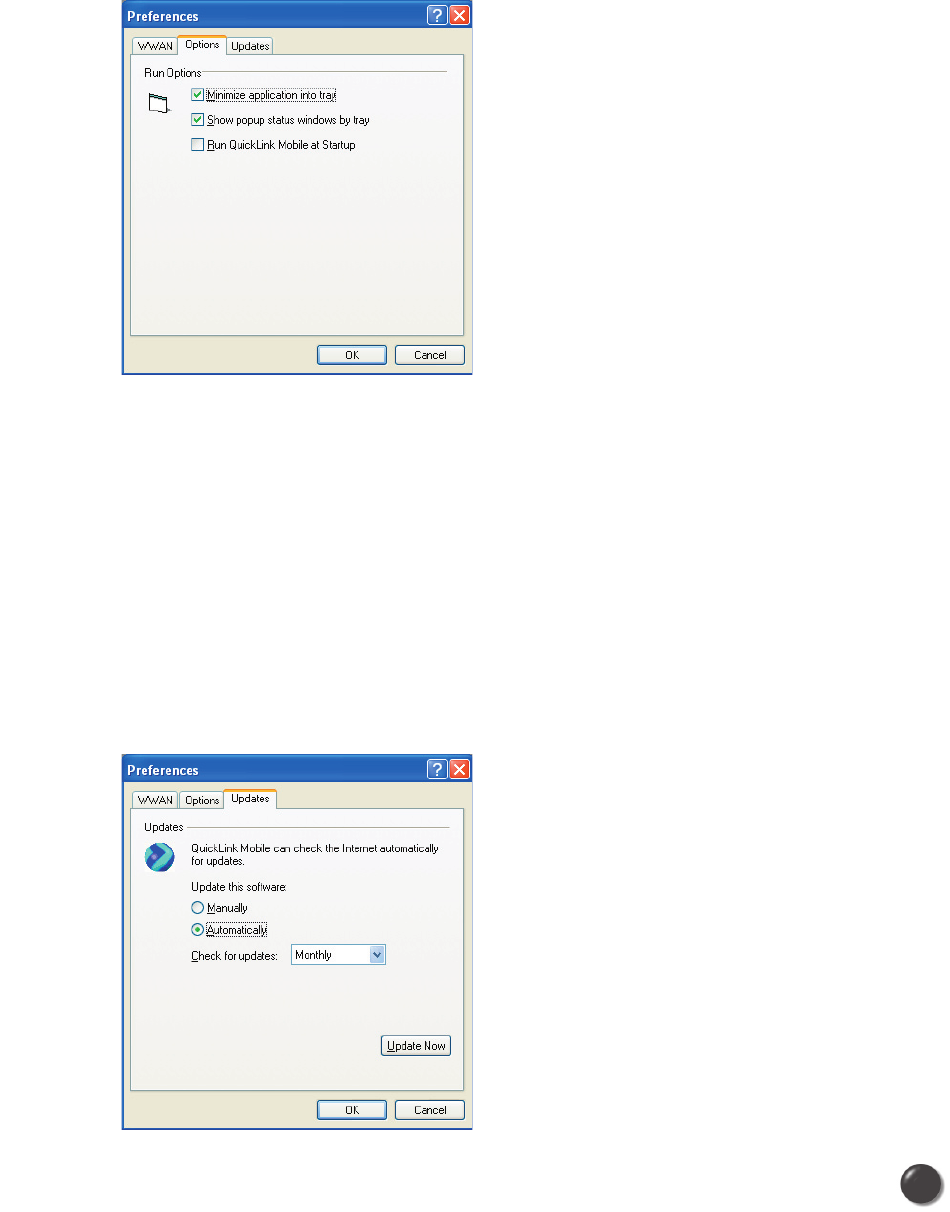
UM
150
User’s Manual 14
UM
150
User’s Manual
4. QUICKLINK MOBILE PREFERENCES
4.1 General Preferences
Options Tab
Click on “Options”, then “Preferences”.
Minimize application into tray: When you minimize the application it will now
show in the Windows task bar. To restore the application click on the QuickLink
Mobile tray icon, and select Show Application.
Show popup status windows by tray: Displays small popup sliding windows in
the lower right corner of the screen when connections are made, and when
network connections are lost.
Run QuickLink Mobile at Startup: Automatically launches QuickLink Mobile
whenever you start your computer.
Updates Tab

UM
150
User’s Manual 15
UM
150
User’s Manual
This feature allows QuickLink Mobile to automatically check for software updates.
If an update is available, you will be notified of its size and approximate download
times if using Alltel Wireless Internet.
You will be given the choice to download or cancel. If you select download,
a display appears that shows the progress as the update is downloading with the
option to cancel if desired. You do not need to download the updates wirelessly;
you can use any connection to the Internet.
Note: If you download the updates wirelessly, normal usage charges apply.
You can allow the software to automatically check for updates, daily, weekly
(default), or monthly. It only checks when the application is running and when
it detects that you are connected and able to access to the Internet. If desired,
you can select “Manually” and the software will only check for updates when
you select “Update Now” (pictured above), or you when you select, from
QuickLink Mobile’s main screen, “Help”, “Check for Updates”.
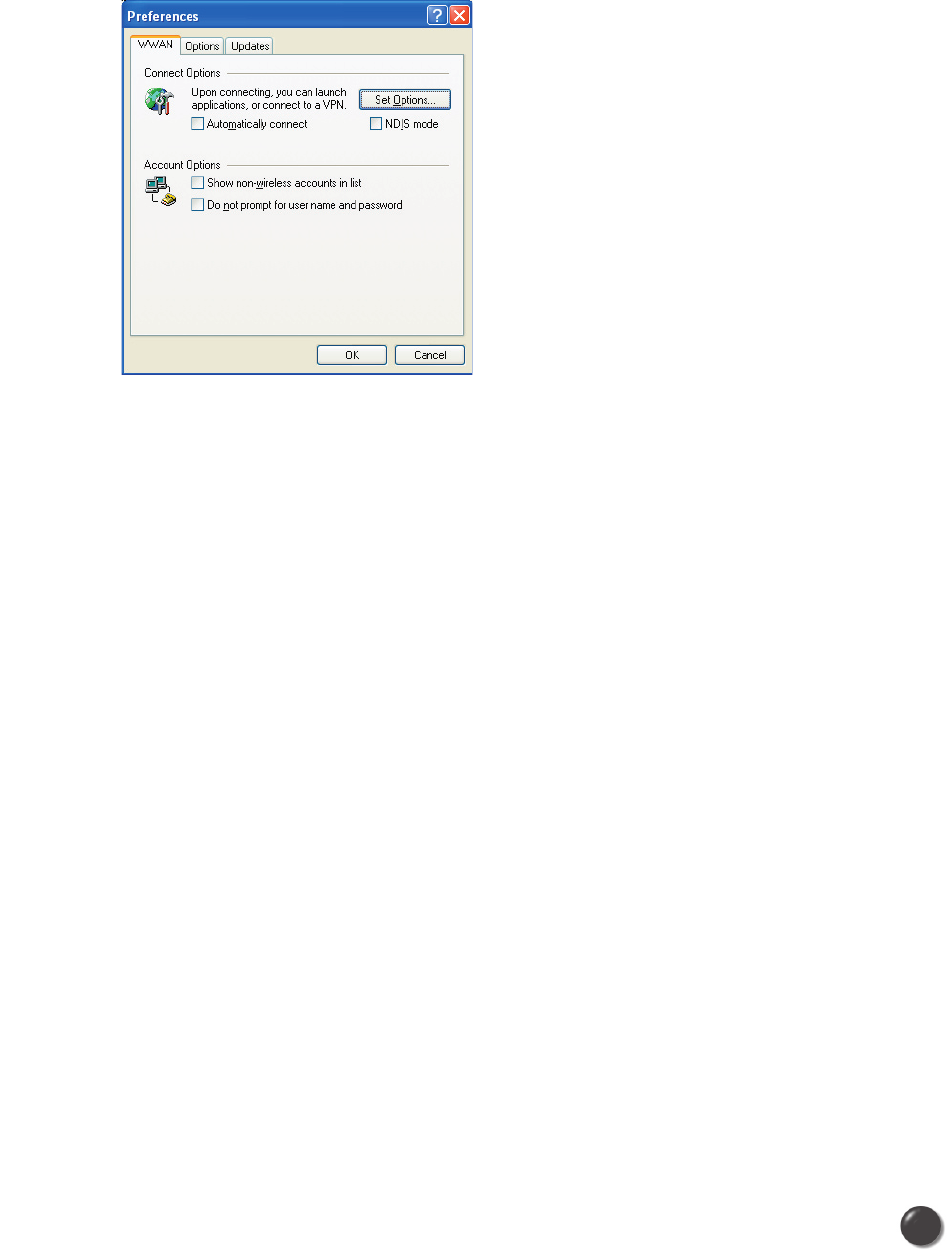
UM
150
User’s Manual 16
UM
150
User’s Manual
4.2 WWAN Specific Settings
WWAN Preferences
Click on “Options”, then “Preferences”.
WWAN Options
Set Options . . . : This is used to set various WWAN connection settings. See below.
Automatically Connect: If desired, you can select to have QuickLink Mobile
automatically connect to Alltel Wireless Internet at application startup.
Show non-wireless accounts in list: If you select this option all of your dial up
accounts will appear in QuickLink Mobile’s list of accounts, allowing you to use
QuickLink Mobile to launch them instead of Dial-Up Networking. With this option
unchecked, the only connections that are displayed in QuickLink Mobile’s list of
accounts, are the Alltel Wireless Internet, (depending on your wireless phone/device
capabilities) and any Wireless connections you have created, manually or with the
Copy Accounts Wizard.
Do not prompt for user name and password: If you are only using the Alltel
Wireless Internet connection, this setting has no effect. If you created Wireless
connections to dial into other networks or have existing connections you are going
to launch using QuickLink Mobile, checking this option will skip the screen that
normally asks for your user name and password. For this to work you will have had
to connect previously, successfully saving your user name and password.
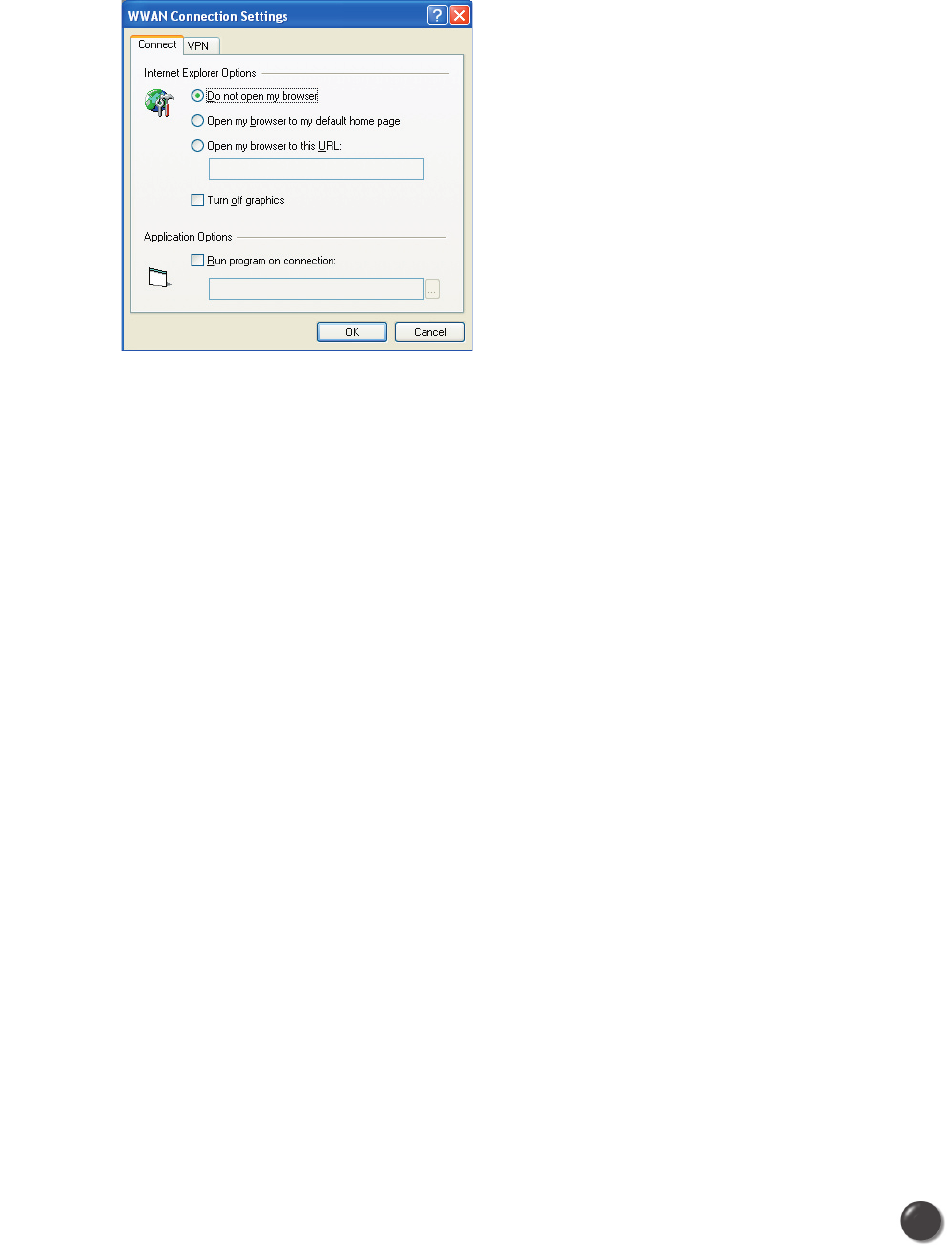
UM
150
User’s Manual 17
UM
150
User’s Manual
Connect Tab
When you select the “Set Options” button from the screen above, the
following options will appear (“Options”, “Preferences”, “WWAN tab”,
“Set Options . . .”) :
Do not open my browser: With this option selected, when you connect to a
WWAN network, QuickLink Mobile will not automatically launch your default
web browser.
Open my browser to my default home page: With this option selected, when
you connect to a WWAN network (Alltel Wireless Internet), QuickLink Mobile will
automatically launch your default web browser and load your home page.
Open my browser to this URL: With this option selected, when you connect to a
WWAN network (Alltel Wireless Internet), QuickLink Mobile will automatically launch
your default web browser but do it in such a way that the URL you specify will load
instead of your home page.
Turn off graphics: If you select this it will turn off graphics in Internet Explorer.
With these options off, web pages will load faster but you will have to right click
and select “show picture” for any pictures you want to see. With the added
performance of the internet accelerator software when using the Alltel Wireless
Internet connection, most users prefer to see graphics and have audio support,
so the default setting for both options is unchecked.
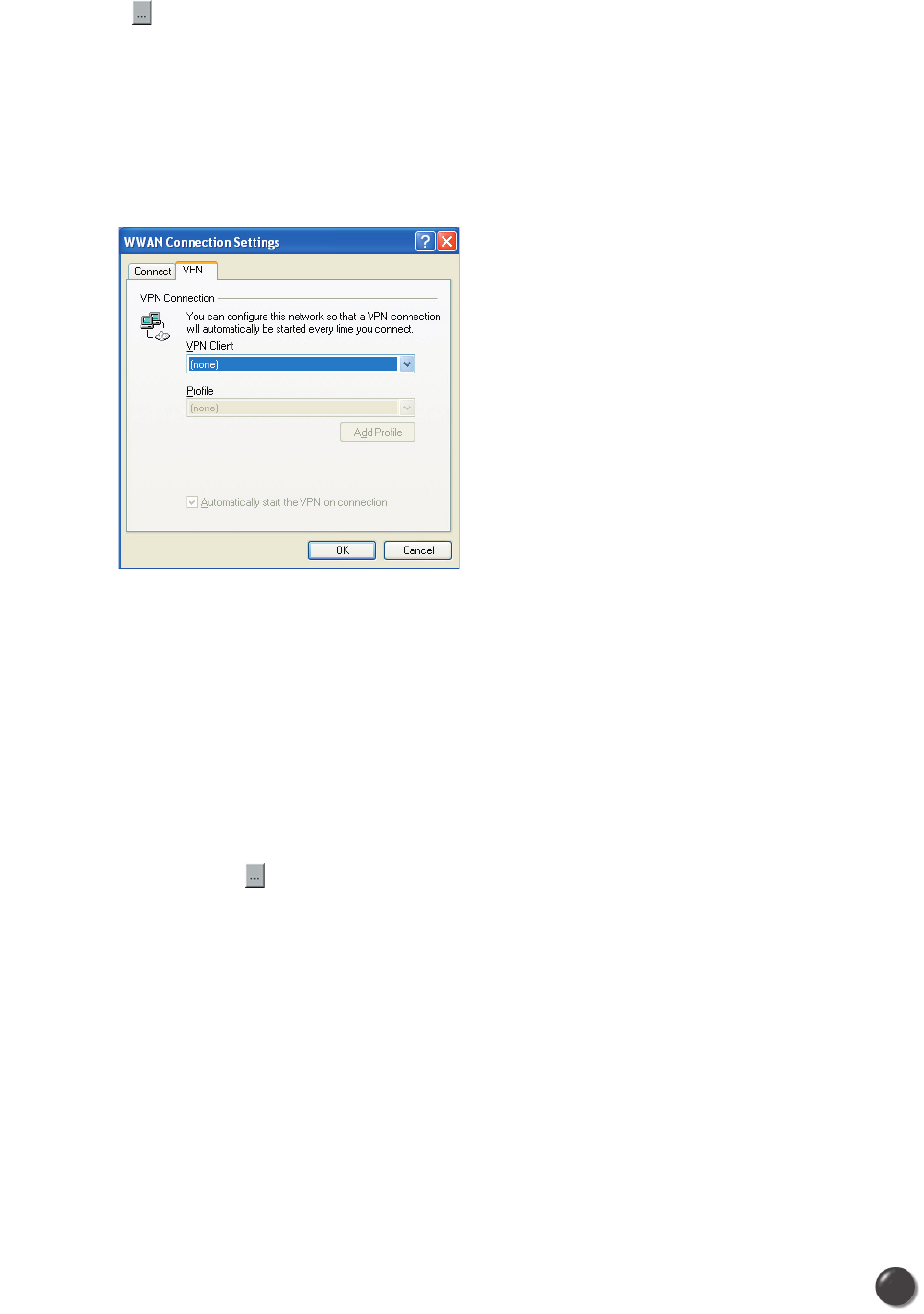
UM
150
User’s Manual 18
UM
150
User’s Manual
Run program on connection: This allows automatically running a program when
you use QuickLink Mobile to connect to a WWAN network. Select the browse
button, , to browse to the desired application you want to run when you connect
to a WWAN network using QuickLink Mobile. The application will run for all WWAN
connections made from QuickLink Mobile.
VPN Tab
The following options exist on the VPN tab (“Options”, “Preferences”,
“WWAN” tab, “Set Options. . . “, “VPN” tab) :
VPN Client: QuickLink Mobile automatically detects if certain VPN clients
like Microsoft®, Cisco®, CheckPoint®, etc are installed on the computer
and allows you to select the one you wish to use. Check with your network
administrator to setup your VPN connection.
If the VPN client you wish to use does not appear in the list, you can select
Other VPN Application.
Other VPN Application: This allows running a VPN program when QuickLink
Mobile connects to a network. Enter the full path to an executable, or select
the browse button, , to find the path to the desired application.
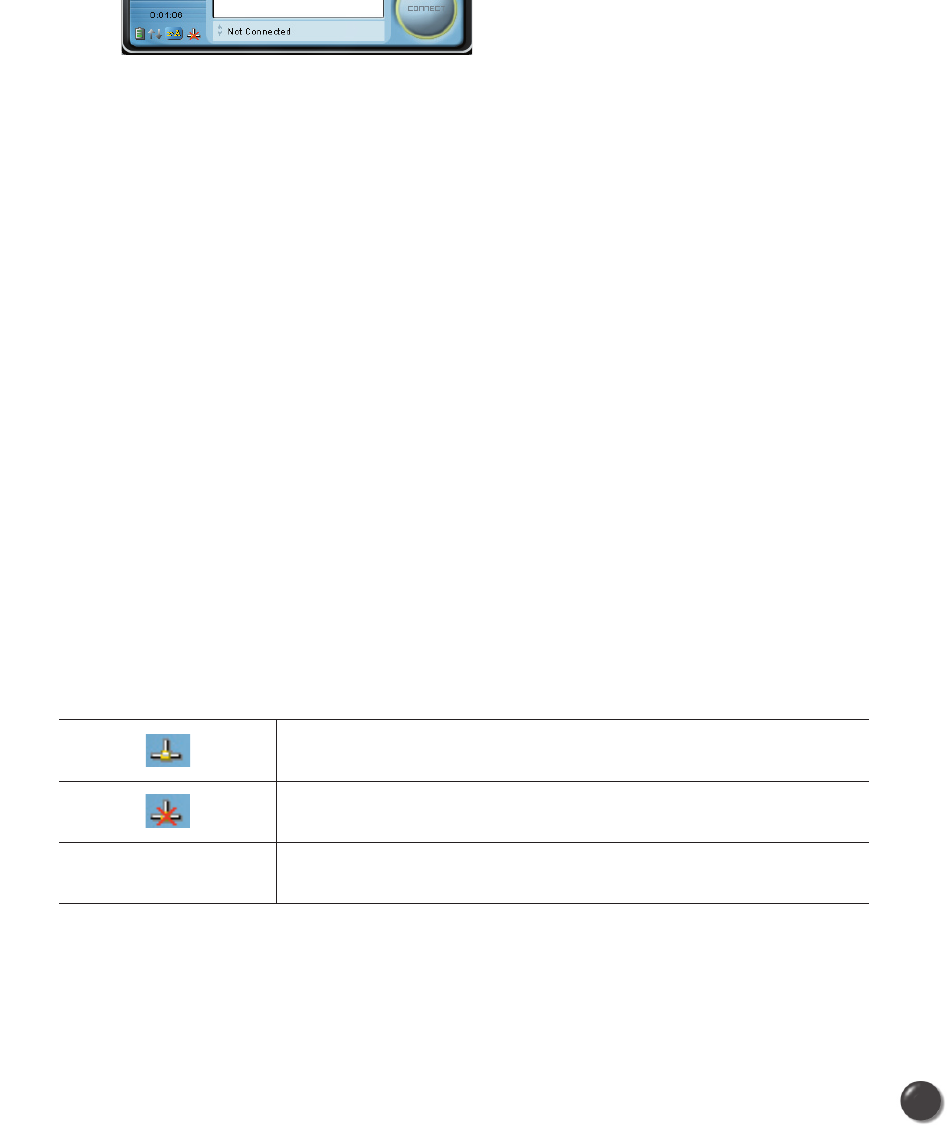
UM
150
User’s Manual 19
UM
150
User’s Manual
4.3 Additional Features
In addition to the basic features mentioned in previous sections, QuickLink Mobile
has the additional features listed below.
The Status Bar
The details of your current connection can be seen in the status bar at the
bottom of the QuickLink Mobile interface. This status bar is always visible when
the interface is fully expanded.
Connection Status
The text on the status bar reflects your current state. During an active connection,
this text will change to “Connected”. If you are not connected, it will display “Not
Connected”.
WWAN Wireless Internet Card Status Area
The text can change to the following:
• Device not inserted: Your WWAN Wireless Internet Card is removed from the
computer.
• Device not activated: Your Wireless Internet Card needs to be activated.
Select Activation from the Tools menu.
Coverage
For Wireless Internet Cards, an icon will display if you are in Alltel Wireless Internet
coverage. Hover the mouse to see the tool tip showing the name of the current
network.
NDIS
The following icons also appear on the status bar to indicate your device’s NDIS status:
NDIS is enabled and connected
NDIS is enabled but disconnected
(No NDIS image) NDIS is disabled.
Throughput
The amount of data that you have sent and received since the current network
connection was initiated can be seen by holding the mouse over the green up
and down arrows on the left side of the status bar.
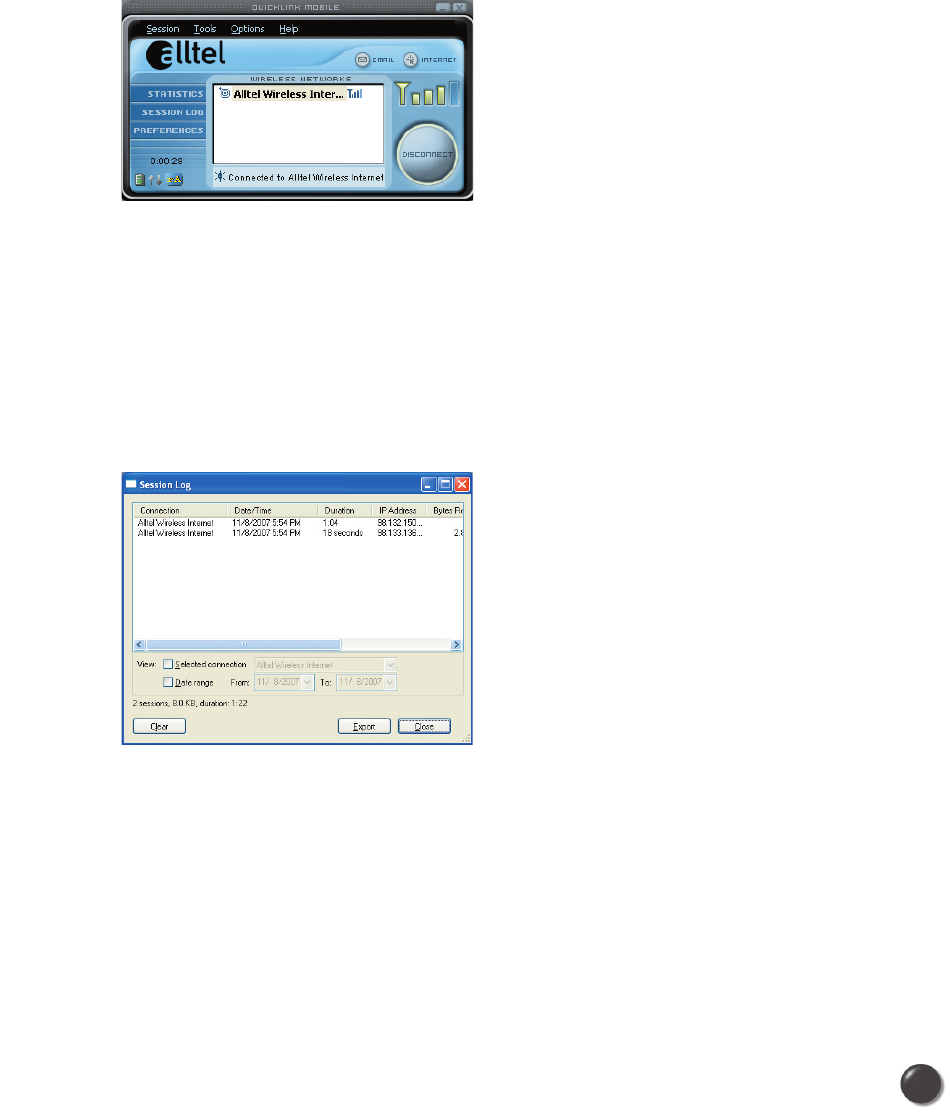
UM
150
User’s Manual 20
UM
150
User’s Manual
Battery Level
The current battery level of your mobile phone can be seen on the left side of
the status bar.
Elapsed Time
The amount of time that has elapsed since the current network connection was
initiated is tracked on the lower left side of the status bar.
The Session Menu
Connect / Disconnect: You can connect or disconnect the wireless networks.
Log: This provides a concise session log of your network activity. Click on a
column heading to sort the log. This window also displays the total number of
sessions as well as the total time connected.
The information displayed in the Usage log can be customized using the
controls that appear just below the list.
To view only the connection history of a specific network type, check the
“Selected connection” checkbox and select the desired type from the drop-
down list. To view only the connections made during a specific interval, check
the “Date range” checkbox and specify the date in the “From:” and “To:”
fields.
To export this log as a CSV file, click the Export button that is immediately
above the log. To clear the log, press the Clear button. Note that clearing the
log cannot be undone.
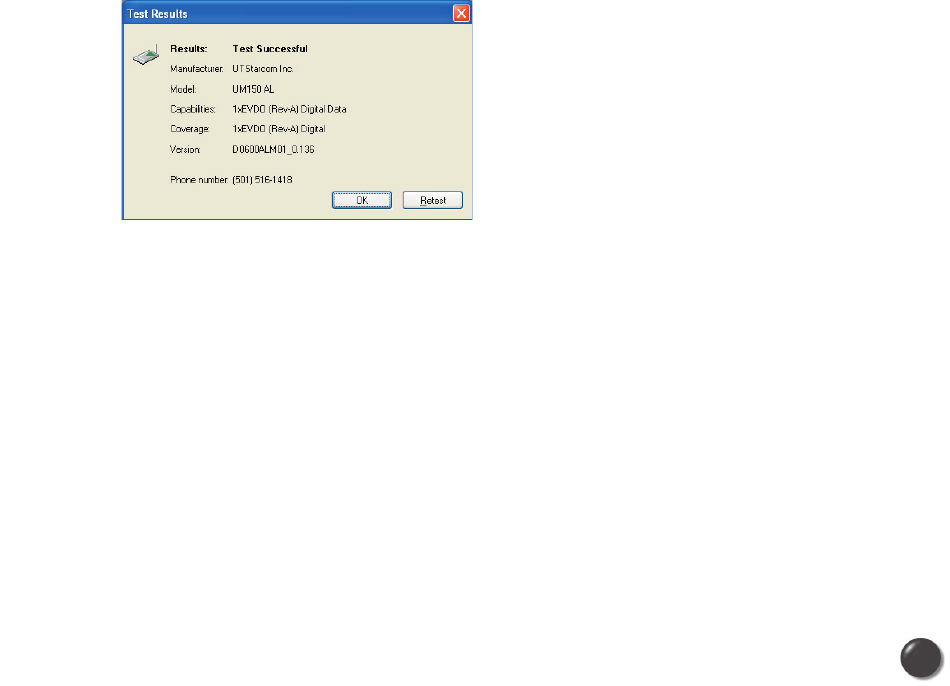
UM
150
User’s Manual 21
UM
150
User’s Manual
Statistics: If you selected to detect and install Alltel during installation, there will be
a Wireless statistics tab with additional information and tools that are helpful in the
event any troubleshooting of the connection is required. You can view key statistics
including bandwidth and your IP address information, release your IP address,
renew your IP address. If you selected to detect and install a WWAN device during
installation, there will be a Statistics tab that will show data speeds during a session
when using the WWAN device. There is also a “My Computer” tab; this tab has
key information about your computer that may be helpful in troubleshooting any
problems that may occur. It also has the option of e-mailing Alltel Wireless Technical
Support.
Close: Exit the application.
The Tools Menu
Refresh Networks: This causes QuickLink Mobile to verify connected devices
and to scan for available Networks. Use this feature if you connected your
equipment after launching QuickLink Mobile. Pressing the F6 function key can
also access this option.
Test WWAN Device: Retrieve and display detailed information about your WWAN
device (Wireless phone and cable or 1xEV-DO/1xRTT/CDMA Wireless Internet
Card) such as manufacturer, model, version, etc. Also, view the current battery (not
with Wireless Internet Cards) and signal strengths. This information can be valuable
when troubleshooting a problem.
Run Wizard: Runs the Setup Wizard again. Useful if you need to reconfigure
QuickLink Mobile to use a new mobile handset or Wireless Internet Card.
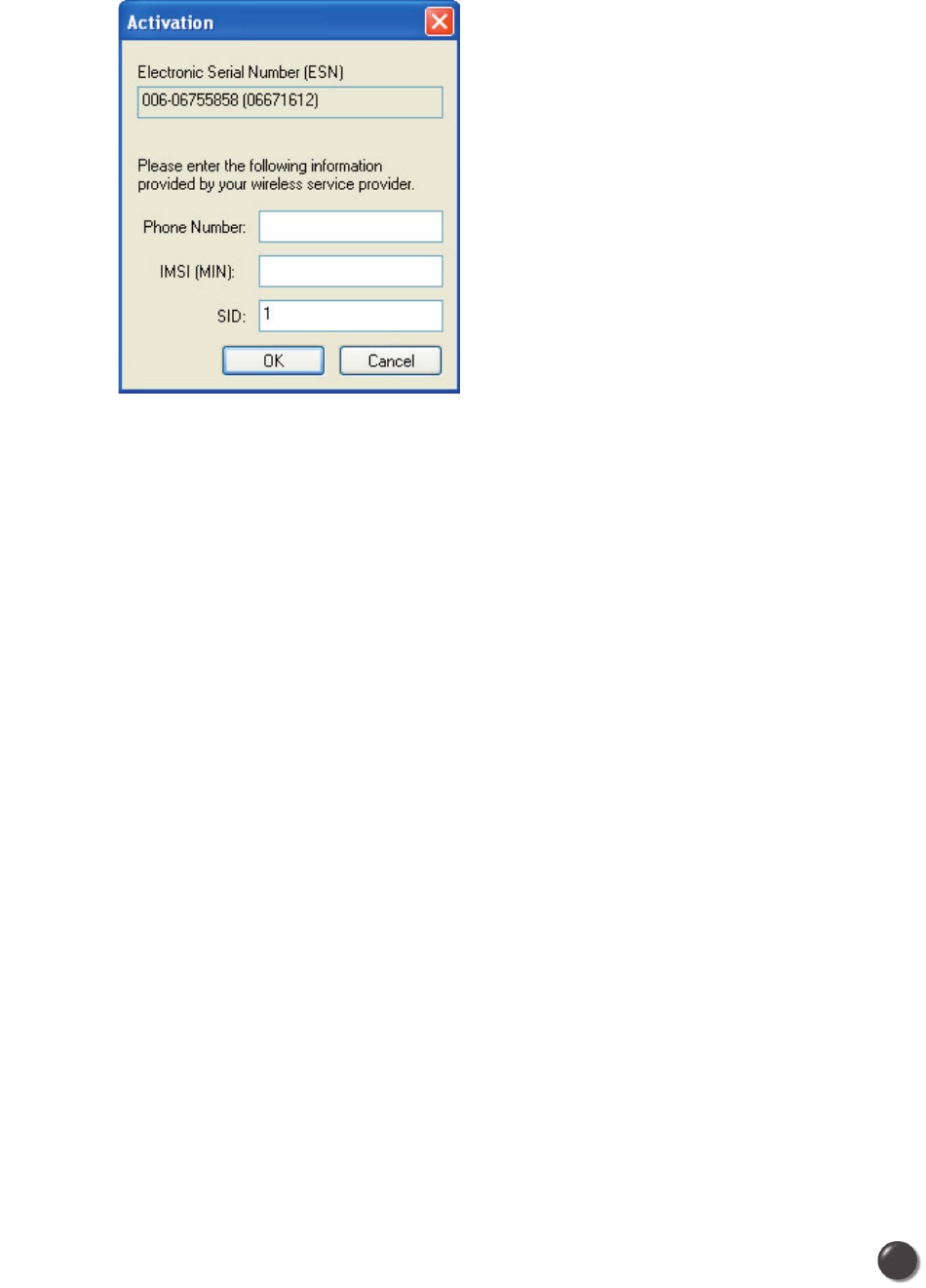
UM
150
User’s Manual 22
UM
150
User’s Manual
Activation: Programs the phone number, MIN, and SID to the Wireless Internet
Card.
Alltel Wireless Internet Setup: Please contact the service provider for details.
The Options Menu
Control Panels: From this menu you have access to your systems “Modem”,
“Network and Dial-Up Connections”, and “Internet” control panels. You can also see
all control panels by selecting “All”.
Dial-Up Accounts: Add, edit, or copy wireless dial-up accounts.
• Add Wireless: This is used to create a wireless dial-up connection from scratch.
• Add Other: This is used to create a regular dial-up connection from scratch.
• Edit: This is used to edit properties of any dial-up connection.
• Copy: See section on Using Dial-Up Connections.
Power ON / Power OFF: This is used to power on/off the Wireless Internet Card.
Preferences: This is used to select preferences for settings related with
connection. Please see WWAN Specific Settings for details.
Always on Top: When checked, the QuickLink Mobile window displays in front
of all other open application windows, even if another window is placed over
QuickLink Mobile Software window.
The “Internet” button
Launches the default web browser on your computer.

UM
150
User’s Manual 23
UM
150
User’s Manual
The “Email” button
Launches the default email application on your computer.
The Help Menu
Displays a variety of help options available to you. Click this button to find
assistance with a problem, to explore the full range of Alltel Wireless and
services, or to contact Alltel Wireless.
Contents: Launches this help file. You can also access this help file from your
installation CD.
Check for Updates: Can be used with any connection to the Internet to check
for software updates for QuickLink Mobile. Note: If downloading an update
wirelessly, normal usage charges apply.
Alltel Home Page: Takes you to the Alltel Wireless home page that contains
information about wireless devices, useful tips and hardware manuals.
Customer Service: This option will attempt to launch your mail client with the
default address to e-mail Alltel Wireless Support.
About QuickLink Mobile: Displays the software version.

UM
150
User’s Manual 24
UM
150
User’s Manual
5. INSTALLING UM
150
5.1 Precautions
1) Do not insert the UM
150
before installing the software on your computer. When
you complete the software installation, the system will prompt you to insert the
UM
150
into the USB port.
2) Once the Wireless Internet Card has been inserted into the computer, do not
remove it from your computer without first completing the unplugging/ejection
process. (See page 27 for more information on this process.)
5.2 Recommended System Requirements
To successfully install and use the UM
150
Wireless Internet Card in your computer,
the following system specifications are required.
Item Required Specification
Operating system
Windows® Vista / Windows® XP / Mac OS X 10.3.9.
Port USB port
Processor
150
MHz or faster
Disk drive CD-ROM
Memory 32 MB
Disk space 14 MB
Dial-up networking DUN bound to TCP/IP
* The UM
150
is useful for Pocket PCs that include a USB port. Also, SMS or voice
service is not supported.

UM
150
User’s Manual 25
UM
150
User’s Manual
5.3 Installing Software
5.3.1 Warnings
• Make sure to complete the unplugging/ejection process before removing the
UM
150
. If you remove the Wireless Internet Card improperly, the product may be
damaged.
• Before inserting the UM
150
into your computer’s Wireless Internet Card port,
remove the Installation CD from the CD-ROM drive.
5.3.2 Notes
• If you have inserted the Wireless Internet Card properly, Windows will inform you
of the new hardware. Wait until Windows completes “Found New Hardware” task.
In Windows XP, several tool tips similar to the “Found New Hardware” function will
appear and disappear in the system tray automatically. Once hardware detection
is complete, you will be prompted to start activation.
• You should hear a short beep sound each time you insert or remove the UM
150
,
which is quite normal. It is an audible notification that your computer recognizes
the new hardware.
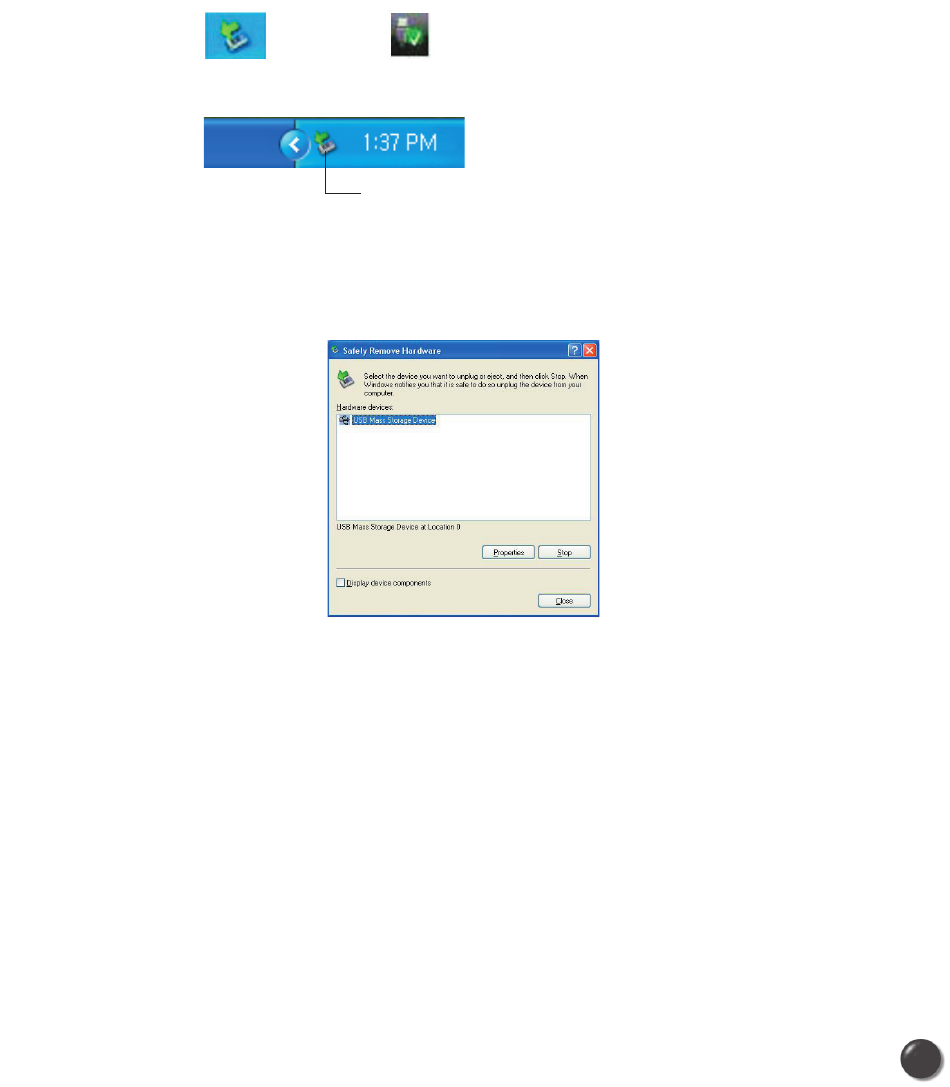
UM
150
User’s Manual 26
UM
150
User’s Manual
5.3.3 Unplugging or Ejecting the Device
Make sure to complete the unplug/eject process on your computer before removing
the UM
150
from your PC. If you remove the USB device improperly, the product may
be damaged.
• WINDOWS
When disconnecting a USB mass storage device from the computer, close all
windows and quit all running applications that are stored on the device and double
click the Unplug/Eject Hardware icon in the System tray.
When you press the Unplug/Eject icon in the system tray, the pop-up window will
appear.
Click the [Stop] button. Now, you can remove the UM
150
from your computer.
Windows XP Vista
Unplug / Eject Hardware icon
System Tray
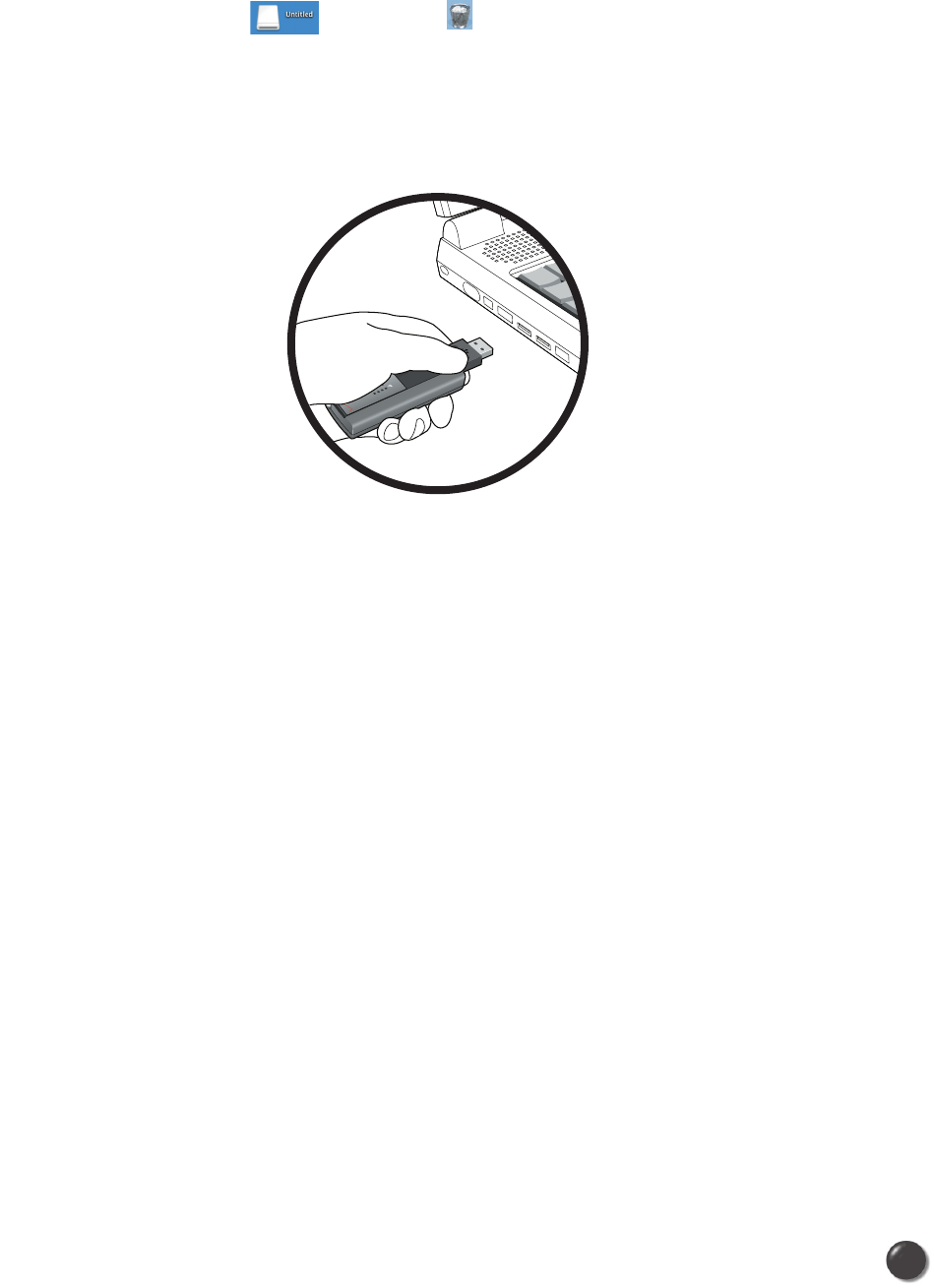
UM
150
User’s Manual 27
UM
150
User’s Manual
• MACINTOSH
When disconnecting a USB mass storage device from the computer, close all
windows and quit all running applications that are stored on the device and drag
the device’s icon ( ) onto trash ( ) to dismount it from the Desktop prior to
unplugging the device from the USB port or Hub.
* When removing the UM
150
, always grip the top and bottom of the modem and
push/pull carefully.
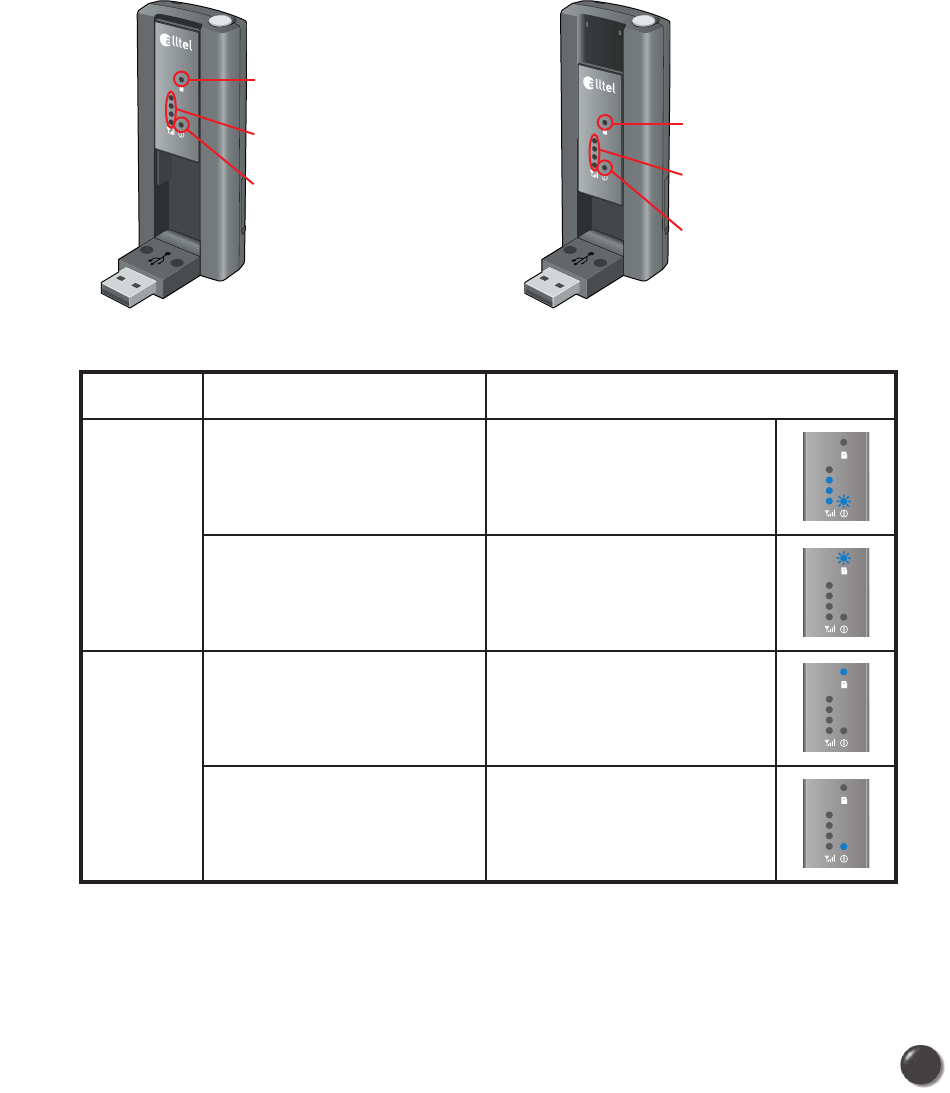
UM
150
User’s Manual 28
UM
150
User’s Manual
5.3.4 Using the Device
The usage mode is set by sliding the window up or down before
connecting to your PC.
• To use the UM
150
as both a modem and mass storage device, slide the window
up and insert the UM
150
into a PC USB port. To use it as a mass storage device
only, slide the window down and insert the UM
150
into a PC USB port.
Function Operation LED Status
Modem
and
Mass
storage
Slide the window up
➡ Insert to PC USB port
➊ OFF
➋ ON (Blue light level
shows signal strength)
➌ ON (Blue light blinks)
Slide the window up
➡ Insert to PC USB port
➡ Slide the window down
➊ ON (Blue light blinks)
➋ OFF
➌ OFF
Mass
storage
only
Slide the window down
➡ Insert to PC USB port
➊ ON (Blue light stays on)
➋ OFF
➌ OFF
Slide the window down
➡ Insert to PC USB port
➡ Slide the window up
➊ OFF
➋ OFF
➌ ON (Blue light stays on)
* To use the UM
150
only as a mass storage on a computer that does not have
Quick Link Mobile installed, slide the window down and insert it into a PC USB
port.
Window slide
up condition
➊ Mass storage ONLY
indicator (disabled)
➋ Signal strength indicator
(enabled)
➌ Power status LED
(enabled)
Window slide
down condition
➊ Mass storage ONLY
indicator (enabled)
➋ Signal strength indicator
(disabled)
➌ Power status LED
(disabled)
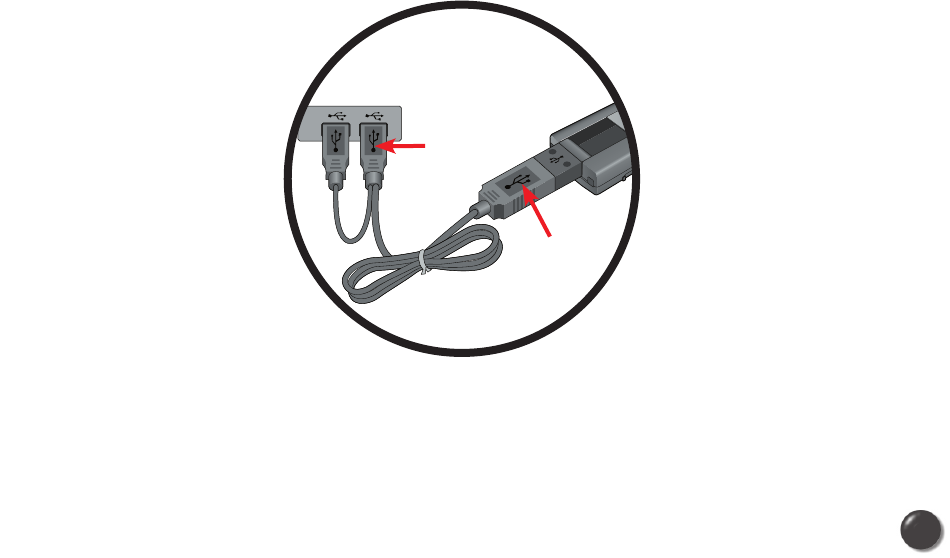
UM
150
User’s Manual 29
UM
150
User’s Manual
5.3.5 Using the Wireless Internet Card Extension Cable
• The UM
150
Modem package includes an extension USB Y-shaped cable.
Although the cable is not required for use with your UM
150
Modem, it offers
increased performance for your UM
150
Modem under certain operating
conditions. Simply insert the USB connector into the USB port of your
computing device to deliver a DC power supply, increased RF performance,
and to solve clearance issues.
Using the Wireless Internet Card Extension Cable:
1) Plug the single end of the Y-shaped cable into the UM
150
Modem. [A]
2) Depending on the condition you are trying to solve (DC power supply,
increased RF performance, or clearance issues), plug either one of the two
connected ends of the Wireless Internet Card extension cable into the Type A
USB port(s) on your computer. [B]
* The Wireless Internet Card extension cable connector labeled #1, is the
primary data power cable used to either extend the UM
150
modem away
from your computer allowing you to locate the modem in a more optimum
signal location or solve any computer USB port clearance issues. The
Wireless Internet Card extension cable connector labeled #2, is a DC power
supply cable and must be used with connector #1 to provide the modem up
to 1Amp of current for use in weaker signal areas.
3) The device is connected to and powered by the computer as soon as the
USB cable is plugged properly into the appropriate Type A USB port(s).
4) Launch Quick Link Mobile and click Connect.
A
B
#1
#2
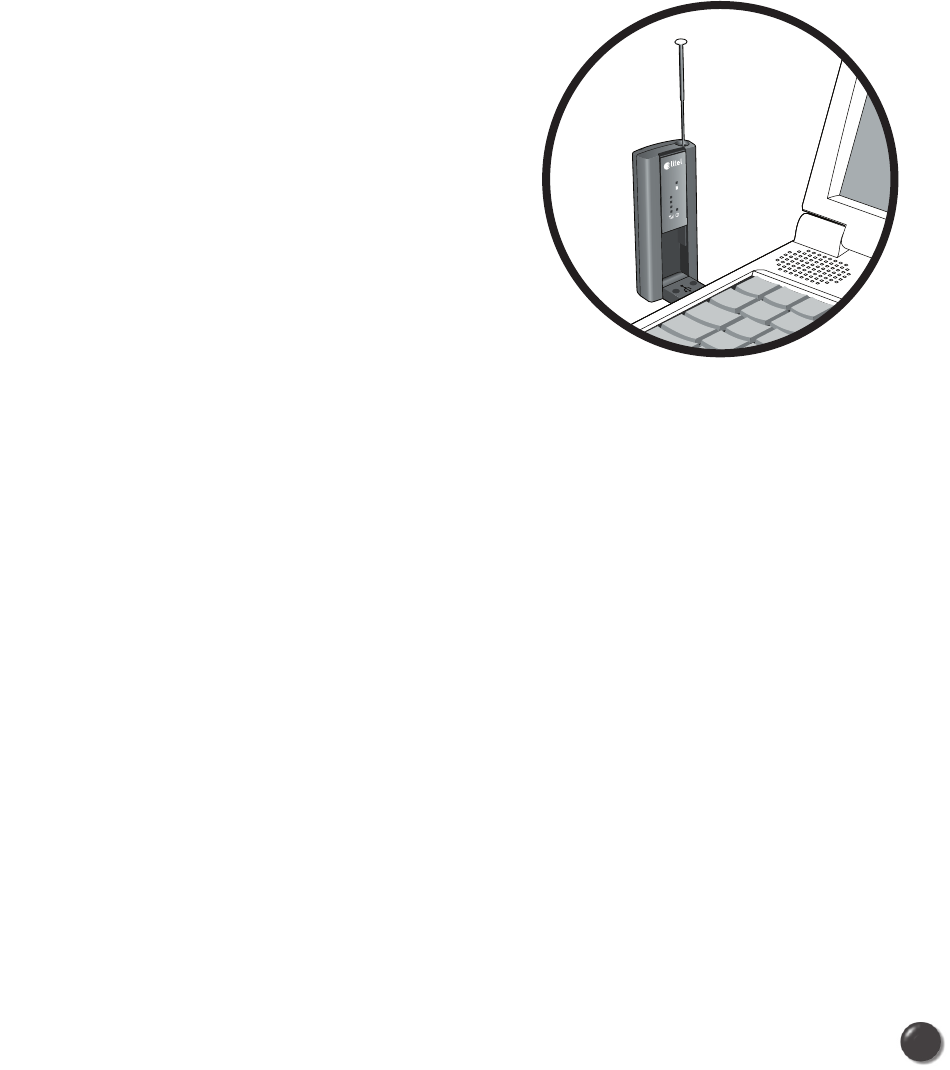
UM
150
User’s Manual 30
UM
150
User’s Manual
6. REGULATORY AND SAFETY INFORMATION
6.1 Regulatory Notices
UM
150
complies with Parts 15, 22, and 24 of the FCC rules. It has been tested
with the typical personal computer with a USB port. This USB device must not be
co-located or operated in conjunction with any other antenna or transmitter. If you
use this USB device in any other configuration, the FCC RF Exposure compliance
limit can be exceeded.
6.2 Operating Conditions
1) This device does not cause harmful
interference, and this device must
accept any interference received,
including interference that may
cause undesirable operations.
2) The manufacturer stipulates that
the antenna should be more than
1.5 cm (0.60”) from by-standers
and 1.0cm (0.39”) from the user.
6.3 Warnings and Cautions
1) Modifying or changing this USB device without express authorization
can nullify compliance with RF exposure guidelines.
2) This USB device has been tested and found to comply with the limits pursuant
to Part 15, 22, and 24 of the FCC Rules.
These limits are designed to provide reasonable protection against
harmful interference when appropriately installed.
This USB device generates, uses, and can radiate radio frequency and, if not
installed and used according to the instructions provided,
it may cause harmful interference to radio communication.
However, there is no guarantee that interference will not occur in
any particular installation.

UM
150
User’s Manual 31
UM
150
User’s Manual
3) If this USB device does cause harmful interference with radio or television
signals (determine this by turning the USB device off and on), attempt to correct
the interference by trying one or more of the following:
• Reorient or relocate the antenna.
• Increase the distance between the USB device and receiver.
• Connect the USB device into an outlet on a circuit different from that to which
the receiver is connected.
• Consult the dealer or an experienced radio/TV technician for help.
4) This USB device does not exceed the Class B limits for radio noise emissions
from digital apparatus as set out in the interference causing equipment standard
entitled “Digital Apparatus”, ICES-003 of the Department of Communications.
5) If you have purchased this product under a United States Government contract,
it shall be subject to restrictions as set forth in subparagraph (C)(1)(ii) of
Defense Federal Acquisitions Regulations (DFARs) Section 252.227-7013
for Department of Defense contracts, and as set forth in Federal Acquisitions
Regulations (FARs) Section 52.227-19 for civilian agency contracts or any
successor regulations. If further government regulations apply, it is your
responsibility to ensure compliance with such regulations.
6.4 Safety Precautions
1) Data transmission and reception cannot be guaranteed because of the nature
of wireless communications. Data can be delayed, corrupted or lost during
transmission. Even though it is quite rare that significant data delay or loss occurs
if the USB device is used in a normal manner, this USB device should not be
used in cases that data transmission or reception failure could result in damage
of any kind to the user or another party, including but not limited to personal
injury, death or loss of personal property. UTStarcom bears no responsibility for
damages or losses of any kind resulting from delays or errors in data transmission
using the USB device, or for failure of the USB device to transmit or receive such
data.
2) Do not use this USB device in areas where blasting is in progress, where
explosive atmospheres may be present, near medical equipment, life support
equipment, or any equipment which may be susceptible to any form of radio
interference. Turn off this USB device in these areas, since it can transmit signals
that could interfere with this equipment.

UM
150
User’s Manual 32
UM
150
User’s Manual
3) Do not use this USB device in any aircraft whether the aircraft is on the ground or
in flight. Make sure to turn off this USB device in aircraft.
If used in an aircraft, it can transmit signals that could interfere with various
aircraft systems.
4) Do not use this USB device while driving a car, since it can distract driver’s
driving. In some area, using the communication device while driving a car is
illegal.

UM
150
User’s Manual 33
UM
150
User’s Manual
* WARNING: This product contains a chemical known to the State of California
to cause cancer.
* WARNING: This product contains a chemical known to the State of California
to cause birth defects or other reproductive harm.

UM
150
User’s Manual 34
UM
150
User’s Manual
SPECIFIC ABSORPTION RATES (SAR)
Maximum: SAR 0.344 W/kg CDMA835 Body
SAR 0.328 W/kg PCS1900 Body
THIS MODEL PHONE MEETS THE GOVERNMENT’S REQUIREMENTS
FOR EXPOSURE TO RADIO WAVES.
Your wireless phone is a radio transmitter and receiver. It is designed and
manufactured not to exceed the emission limits for exposure to radiofrequency (RF)
energy set by the Federal Communications Commission of the U.S. Government.
These limits are part of comprehensive guidelines and establish permitted levels
of RF energy for the general population. The guidelines are based on standards
that were developed by independent scientific organizations through periodic and
thorough evaluation of scientific studies. The standards include a substantial safety
margin designed to assure the safety of all persons, regardless of age and health. The
exposure standard for wireless mobile phones employs a unit of measurement known
as the Specific Absorption Rate, or SAR. The SAR limit set by the FCC is 1.6 W/kg. *
Tests for SAR are conducted with the phone transmitting at its highest certified power
level in all tested frequency bands. Although the SAR is determined at the highest
certified power level, the actual SAR level of the phone while operating can be well
below the maximum value. This is because the phone is designed to operate at
multiple power levels so as to use only the power required to reach the network. In
general, the closer you are to a wireless base station antenna, the lower the power
output. Before a phone model is available for sale to the public, it must be tested and
certified to the FCC that it does not exceed the limit established by the government
adopted requirement for safe exposure. The tests are performed in positions and
locations (e.g., at the ear and worn on the body) as required by the FCC for each
model. The highest SAR value for this model phone when tested for use at the
when worn on the body , as described in this user guide, is 0.93 W/Kg. (Body-worn
measurements differ among phone models, depending upon available accessories
and FCC requirements). While there may be differences between the SAR levels of
various phones and at various positions, they all meet the government requirement
for safe exposure. The FCC has granted an Equipment Authorization for this model
phone with all reported SAR levels evaluated as in compliance with the FCC RF
exposure guidelines. SAR information on this model phone is on file with the FCC and
can be found under the Display Grant section of http://www.fcc.gov/ oet/fccid after
searching on FCC ID: PP4PX-600.
Additional information on Specific Absorption Rates (SAR) can be found on the
Cellular Telecommunications Industry Asso-ciation (CTIA) web-site at
http://www.wow-com.com.
* In the United States and Canada, the SAR limit for mobile phones used by the public is
1.6 watts/kg (W/kg) averaged over one gram of tissue. The standard incorporates a sub-
stantial margin of safety to give additional protection for the public and to account for
any variations in measurements.

UM
150
User’s Manual 35
UM
150
User’s Manual
SAFETY INFORMATION FOR RF EXPOSURE
Body worn operation
This device was tested in multiple notebook computer configurations with USB
port configurations for typical near-body operations with the back of the USB
Modem kept 20mm from the body. To maintain compliance with FCC RF exposure
requirements it can be used in notebook computers with substantially similar physical
dimensions,construction, and electrical and RF characteristics,and that maintain
a minimum 20mm separation distance between the user’s body and the back of
the USB Modem, including the antenna. The antenna(s) used for this USB Modem
must not be co-located or must not operate in conjunction with any other antenna or
transmitter within a host device.
Safety Information
SAFETY INFORMATION FOR FIXED WIRELESS TERMINALS POTENTIALLY
EXPLOSIVE ATMOSPHERES
Turn your phone OFF when in any area with a potentially explosive atmosphere and
obey all signs and instructions. Sparks in such areas could cause an explosion or fire
resulting in bodily injury or even death.
INTERFERENCE TO MEDICAL DIVICES
Certain electronic equipment may be shielded against RF signal from you wireless
phone. (pacemakers, Hearing Aids, and so on) Turn your phone OFF in health c are
facilities when any regulations posted in these areas instruct you to do so. RF signals
may affect improperly installed or inadequately shielded electronic system in motor
vehicles.
EXPOSURE TO RF ENERGY
Use only the supplied or an approved replacement antenna. Do not touch the antenna
unnecessarily when the phone is in use. Do not move the antenna close to, or
couching any exposed part of the body when making a call.
FCC Compliance Information
This device complies with Part 15 of FCC Rules.
Operation is subject to the following two conditions:
(1) This device may not cause harmful interference, and
(2) This device must accept any interference received.
Including interference that may cause undesired operation.

UM
150
User’s Manual 36
UM
150
User’s Manual
U.S.A.
U.S.FEDERAL COMMUNICATIONS COMMISSION
RADIO FREQUENCY INTERFERENCE STATEMENT
INFORMATION TO THE USER
NOTE : This equipment has been tested and found to comply with the limits
for a Class B digital device pursuant to Part 15 of the FCC Rules. These limits
are designed to provide reasonable protection against harmful Interference in
a residential installation This equipment generates, uses, and can radiate radio
frequency energy and, if Not installed and used in accordance with the instructions,
may cause harmful Interference to radio communications. However, there is no
guarantee that interference will not occur in a particular Installation. If this equipment
does cause harmful interference to radio or television reception, which can be
determined by turning the equipment off and on, the user is encouraged to try to
correct the interference by one or more of the following measures:
*- Reorient or relocate the receiving antenna.
Increase the separation between the equipment and receiver.
*- Connect the equipment into an outlet of a circuit different from that to which the
receiver is connected.
*- Consult the dealer or an experienced radio/TV technician for assistance.
Changes or modification not expressly approved by the party responsible for
Compliance could void the user’s authority to operate the equipment. Connecting
of peripherals requires the use of grounded shielded signal cables.